50 famous food in Japan that you should know about
Discover the rich culinary heritage of Japan with our comprehensive guide to the famous food in Japan. From sushi and ramen to matcha desserts and mochi, explore the flavors, history, and cultural significance of Japan’s most beloved dishes!
Japanese cuisine, known for its emphasis on seasonality, quality ingredients, and meticulous presentation, offers an array of dishes that are both visually stunning and delicious.

From the world-renowned sushi and sashimi to heartwarming bowls of ramen, each dish tells a story of tradition, innovation, and the deep respect for nature inherent in Japanese culture.
In this post, we’ll uncover the essence of traditional Japanese food, exploring not only the popular favorites but also the lesser-known delicacies that contribute to Japan’s rich culinary heritage.
1. Sushi: most famous food in Japan
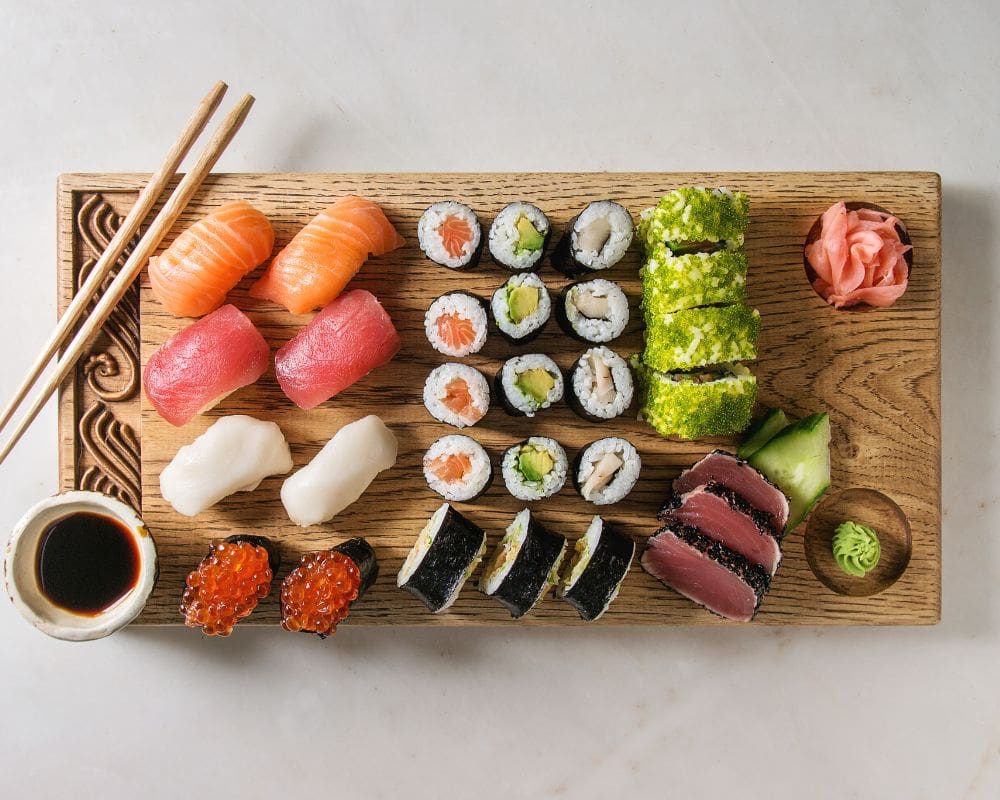
Sushi is probably the most famous food in Japan. It has a storied history that extends back to the Nara period (710-794 AD) when it began as a method of preserving fish in fermented rice.
Today, it refers to a dish featuring vinegared rice combined with various ingredients such as seafood, vegetables, and sometimes tropical fruits.
Sushi is categorized mainly into three types: Nigiri (hand-pressed sushi with a slice of fish over rice), Maki (sushi rolls wrapped in seaweed), and Sashimi (sliced raw fish, no rice).
Fun Fact: Originally, the rice used in fermenting the fish was discarded, and only the fish was consumed. Over centuries, sushi evolved into the artful and edible form we know today, with the vinegared rice becoming a key component of the dish.
🍣 Recommended: Where to eat sushi in Shinjuku, Tokyo
2. Ramen (in various broths such as Shoyu, Miso, and Tonkotsu)

Ramen, a famous food in Japan, is a noodle soup dish that has captured the hearts of people worldwide. Its origins trace back to China, but the dish has been thoroughly Japanized over the centuries, becoming a staple of Japanese cuisine.
Ramen consists of Chinese-style wheat noodles served in a meat or fish-based broth, flavored with soy sauce (Shoyu), miso, or pork bone (Tonkotsu), and topped with ingredients such as sliced pork, nori (seaweed), menma (bamboo shoots), and scallions.
Each region in Japan offers its own variation of ramen, making this dish incredibly diverse.
Fun Fact: Ramen was popularized as a cheap, quick meal for workers in the post-World War II era, leading to its widespread availability and the opening of ramen shops across Japan.
3. Tempura (battered and fried vegetables and seafood)

Tempura is another famous food in Japan, consisting of seafood and vegetables that have been coated in a light, airy batter and deep-fried to perfection.
The dish was introduced to Japan by Portuguese missionaries in the 16th century, and it has since become an integral part of Japanese cuisine.
Tempura is appreciated for its delicate crunch and the way it enhances the natural flavors of the ingredients without overpowering them.
Tempura is a less intimidating entry into Japanese food, thanks to its familiar fried food concept with a unique Japanese twist.
4. Udon (thick wheat noodles in broth)
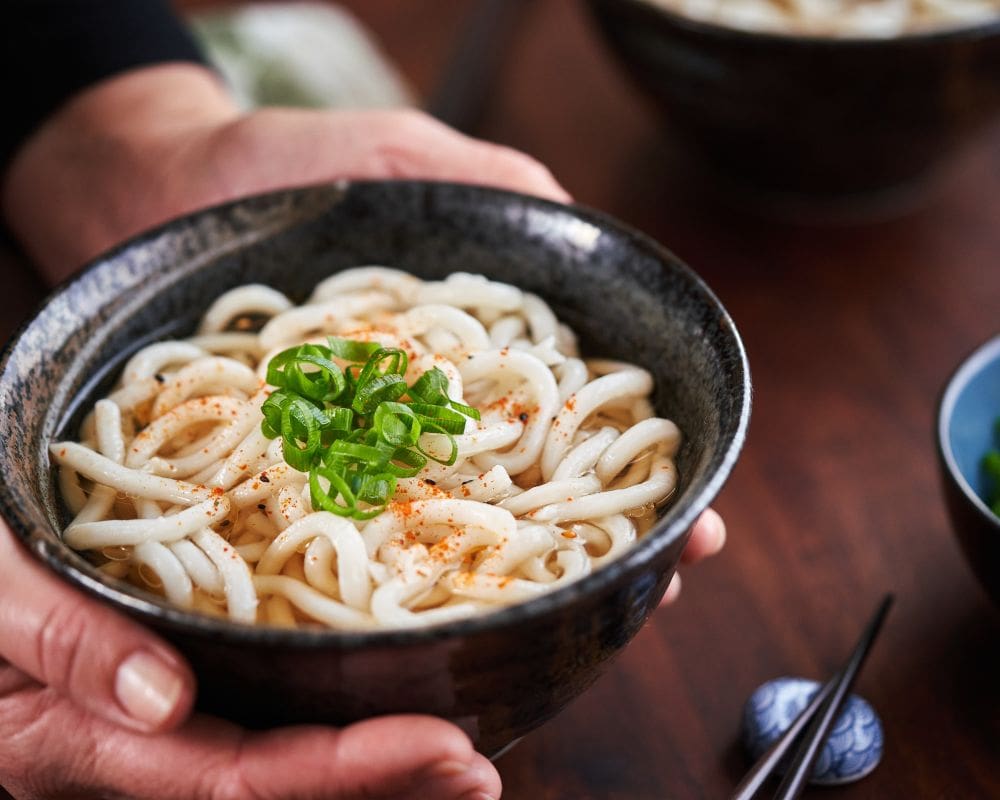
Udon is a type of thick wheat flour noodle that is a famous food in Japan, often served hot in a mildly flavored broth made from dashi, soy sauce, and mirin.
It is believed that udon was introduced to Japan from China in the 9th century. The simplicity of udon has made it a comfort food for many Japanese, with variations in broth and toppings based on regional preferences.
Udon presents a soothing, hearty dish, easily customizable with toppings such as tempura, scallions, and tofu.
Fun Fact: Kagawa Prefecture in Japan is known as the “Udon Prefecture” due to its high consumption and numerous udon restaurants, highlighting the dish’s cultural significance and regional pride.
5. Soba (buckwheat noodles)
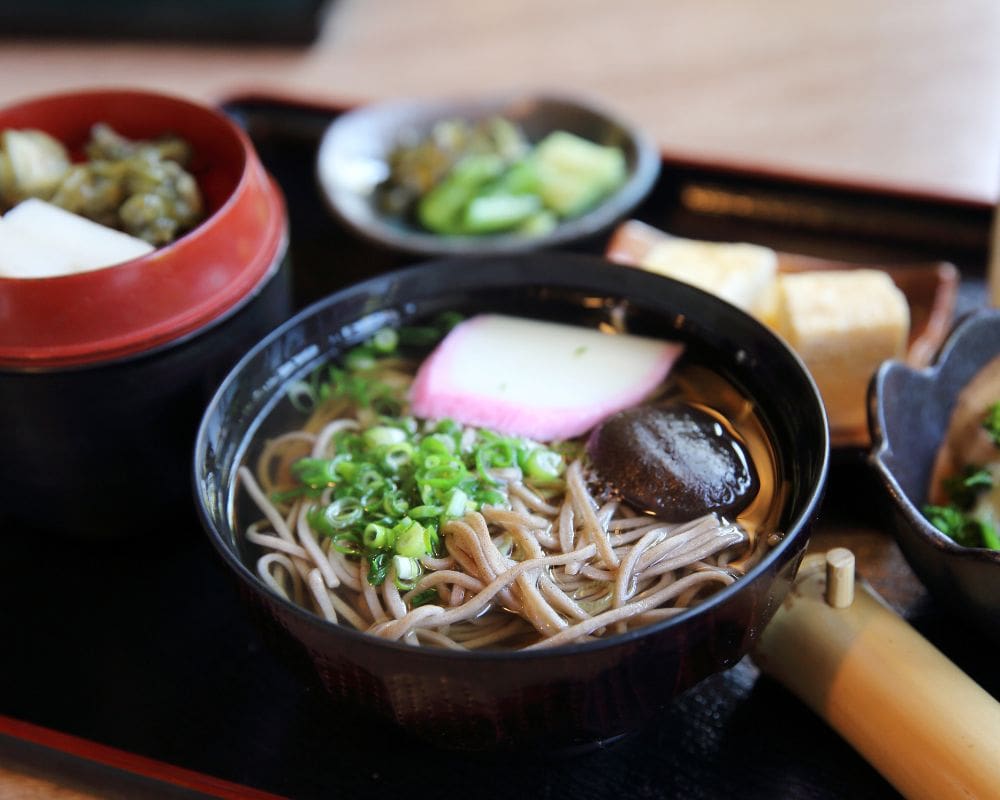
Soba, a famous food in Japan, is made from buckwheat flour, offering a nutty flavor and a firm texture. This dish can be traced back to the Edo period (1603-1868), where it gained popularity for its nutritional value and ease of preparation.
Soba noodles are versatile, served chilled with a dipping sauce or in a hot broth as a noodle soup. This dish is particularly popular on New Year’s Eve, symbolizing longevity.
Soba provides an insight into Japanese dietary culture, showcasing the appreciation for seasonal and simple, yet profound flavors.
Fun Fact: In some Japanese traditions, making soba noodles from scratch is considered an art form, requiring years of practice to perfect the technique of hand-cutting the noodles to the desired thinness.
6. Tonkatsu (breaded and fried pork cutlet)

Tonkatsu consists of a breaded, deep-fried pork cutlet and is one of the most famous food in Japan. Its origins date back to the late 19th century, evolving from European influences during the Meiji era when Japan opened up to the West.
Tonkatsu is typically served with shredded cabbage, rice, miso soup, and a thick, sweet sauce. The dish offers a satisfying crunch and a rich flavor, making it a beloved comfort food among Japanese and foreigners alike.
Fun Fact: Tonkatsu has numerous variations, including katsudon (tonkatsu served over rice with egg) and katsu curry (tonkatsu with curry sauce), demonstrating the adaptability and influence of Western cuisine on Japanese dishes.
7. Okonomiyaki (savory pancake)
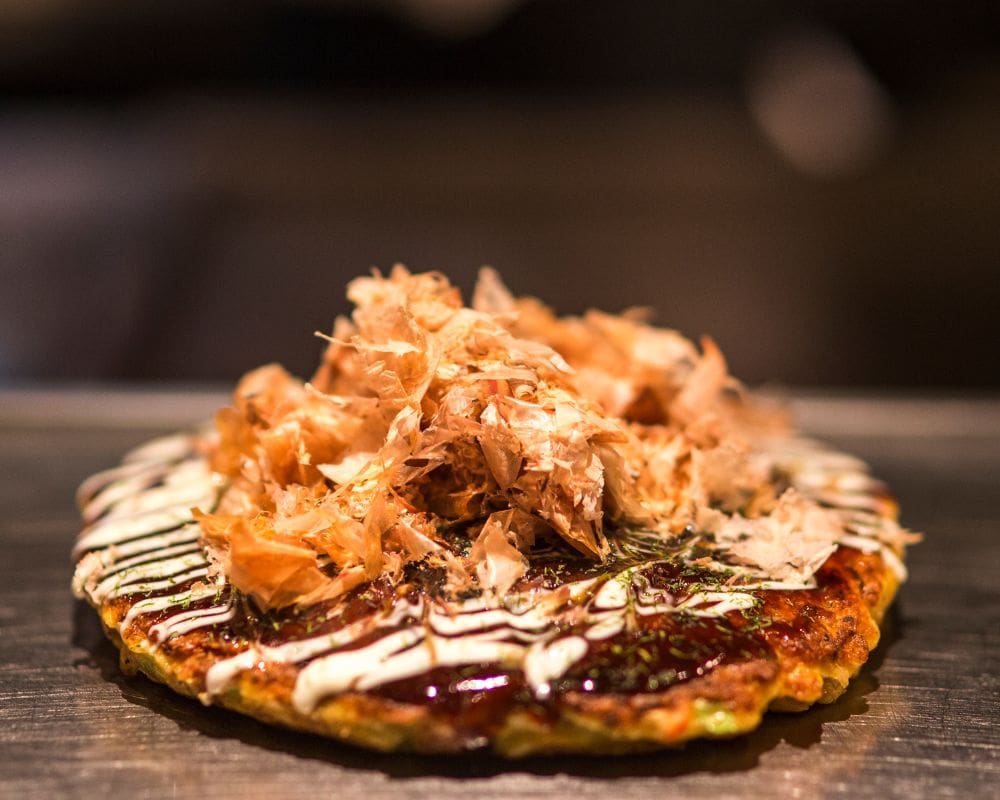
Okonomiyaki, often described as a Japanese savory pancake, is a famous food in Japan made with a batter mixed with cabbage and a variety of other ingredients such as seafood, meat, and vegetables, tailored to personal preference.
The name “okonomiyaki” literally means “grilled as you like it,” highlighting its customizable nature. Originating from the Osaka and Hiroshima regions, each with its own distinct style, this dish embodies the spirit of Japanese communal dining, often cooked at the table on hotplates.
Okonomiyaki offers a fun and interactive eating experience, blending flavors and textures in a unique culinary creation.
Japanese Food Fact: During the food scarcity after World War II, okonomiyaki became popular as a nutritious and filling meal, reflecting its role in Japanese resilience and innovation in cuisine.
8. Takoyaki (octopus balls)
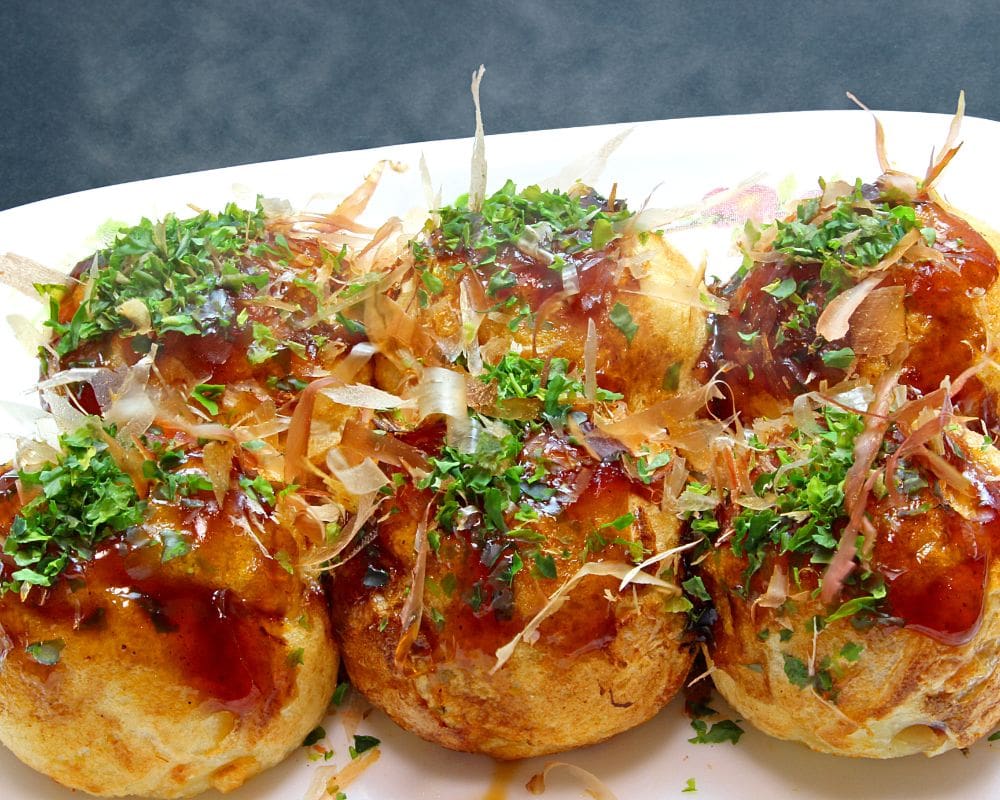
Takoyaki is a famous food in Japan, known as octopus balls, a street food staple originating from Osaka in the mid-20th century.
The snack consists of batter filled with diced octopus, tempura scraps (tenkasu), pickled ginger, and green onion, cooked in a specially molded pan to form round balls.
Takoyaki is typically brushed with takoyaki sauce, similar to Worcestershire sauce, and mayonnaise, then sprinkled with green seaweed (aonori) and bonito flakes.
This dish is beloved for its crispy exterior and gooey interior, providing a delicious taste of Osaka’s street food scene to foreigners.
Fun Fact: Takoyaki was invented by a street vendor named Tomekichi Endo, who was inspired by akashiyaki, a similar dumpling from the Hyogo Prefecture, leading to the widespread popularity of takoyaki as an iconic Japanese snack.
9. Yakitori (grilled chicken skewers)
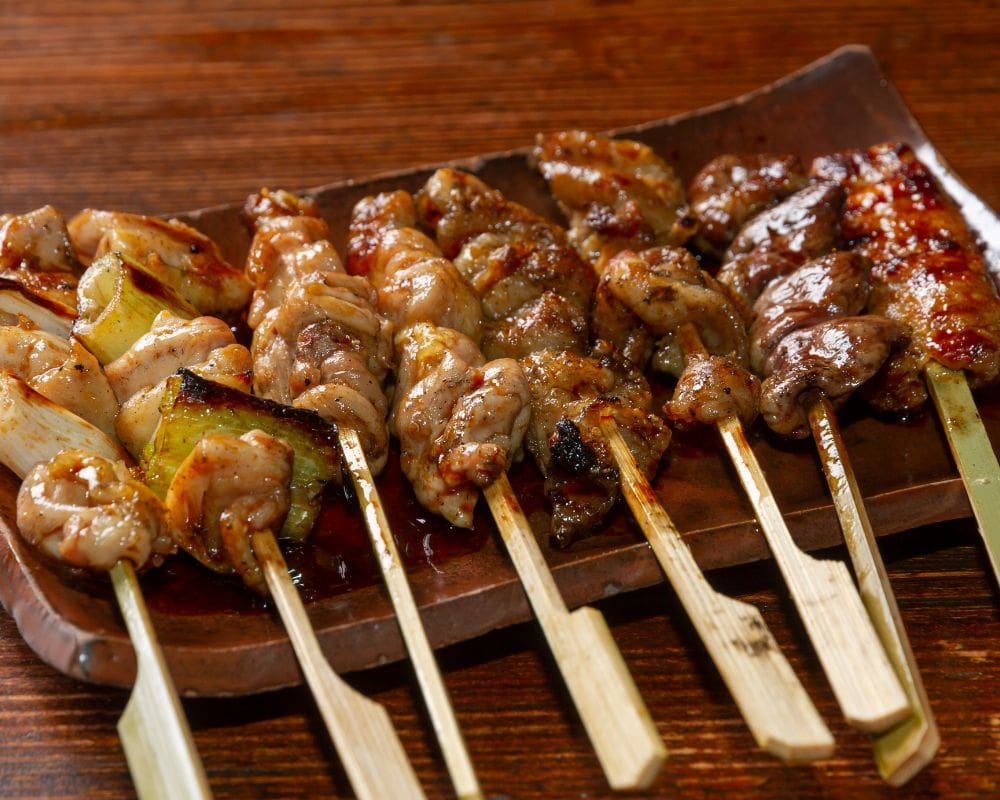
Yakitori, a famous food in Japan, consists of chicken pieces skewered on bamboo sticks and grilled over a charcoal fire.
This dish has its origins in the Edo period (1603-1868) but gained widespread popularity in the post-World War II era as a casual, affordable dining option.
Yakitori includes various parts of the chicken, from the breast and thigh to more exotic parts like liver and cartilage, each seasoned with salt or coated in a savory-sweet sauce called tare.
Yakitori offers an accessible and delicious way to explore the depth of Japanese grilling techniques and the culture’s respect for utilizing all parts of the animal.
Fun Fact: Yakitori is not only a popular izakaya (Japanese pub) food but also a common sight at festivals and street fairs across Japan, symbolizing its role in both everyday and celebratory Japanese cuisine.
10. Kaiseki (traditional multi-course Japanese meal)

Kaiseki, a term synonymous with Japanese culinary sophistication, is a traditional multi-course Japanese meal known for its meticulous preparation, seasonal ingredients, and exquisite presentation.
The roots of kaiseki lie in the simple meals served at the tea ceremonies of the 16th century, but it has evolved into an elaborate dining experience that showcases the pinnacle of Japanese cuisine.
Kaiseki meals consist of a sequence of dishes, each highlighting seasonal flavors and local specialties, served in a specific order designed to harmonize tastes, textures, and colors.
Experiencing kaiseki is an opportunity to appreciate the artistry and philosophy of Japanese cuisine, emphasizing seasonality, quality of ingredients, and culinary craftsmanship.
Fun Fact: Kaiseki embodies the Japanese aesthetic of “wabi-sabi,” the appreciation of beauty in imperfection and transience, reflected in the careful selection of tableware and the presentation of food, making each kaiseki meal a unique and ephemeral work of art.
11. Shabu Shabu (Japanese hotpot)

Shabu Shabu is a famous food in Japan, a type of Japanese hotpot that offers an interactive dining experience. The name “shabu shabu” mimics the sound of ingredients being swished back and forth in boiling water.
This dish was introduced in the mid-20th century and is believed to have Chinese origins. It involves thinly sliced meats, typically beef, and a variety of vegetables and noodles, all cooked piece by piece by diners at the table in a pot of simmering broth.
The cooked ingredients are usually dipped in ponzu or sesame sauce before eating. Shabu shabu is an enjoyable way to experience Japanese cuisine, emphasizing freshness, simplicity, and communal eating.
Shabu shabu is not just a meal but a social event, allowing diners to gather around a pot, cooking and sharing food, embodying the Japanese spirit of harmony and togetherness.
12. Sukiyaki (hot pot style dish with thinly sliced beef)
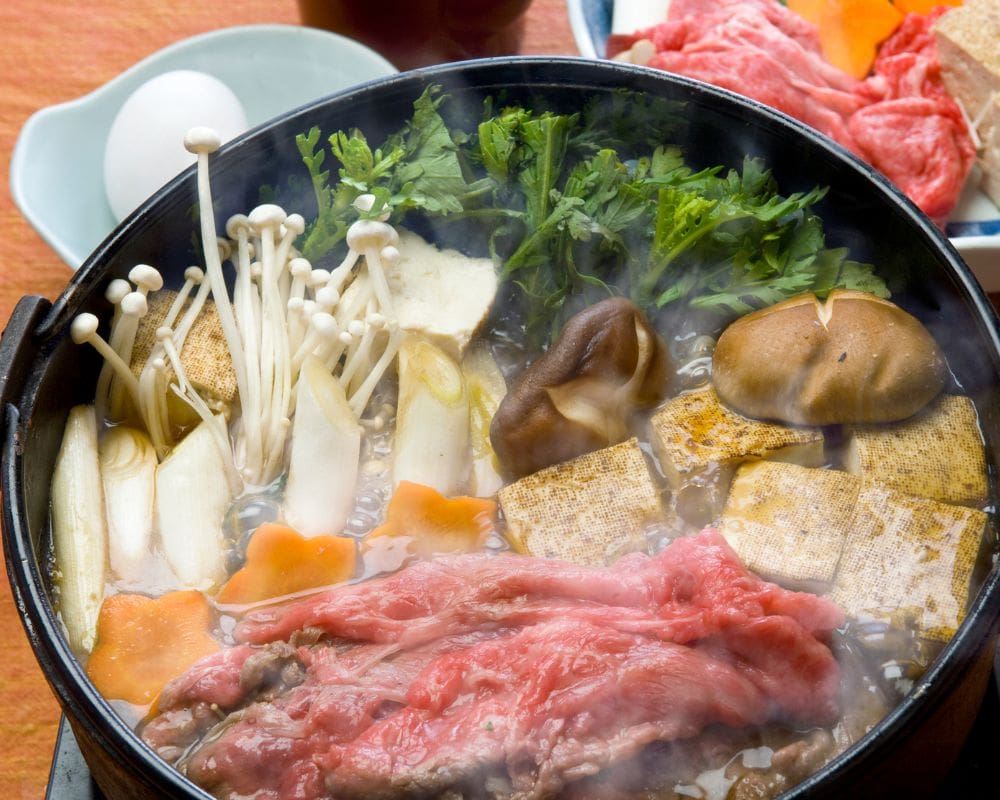
Sukiyaki is a beloved traditional Japanese dish, often served during special occasions and gatherings.
This famous food in Japan consists of thinly sliced beef slowly cooked at the table in a shallow iron pot in a mixture of soy sauce, sugar, and mirin, creating a sweet and savory broth.
Alongside the beef, ingredients like tofu, shirataki noodles, mushrooms, and leafy vegetables are added, making it a rich and flavorful meal.
Sukiyaki became popular during the Meiji era (1868-1912) as eating beef became more culturally accepted in Japan. Sukiyaki offers a taste of Japanese comfort food, showcasing the blend of flavors and the joy of shared eating.
Fun Fact: A traditional way of eating sukiyaki called “warishita,” where raw, beaten eggs are used as a dipping sauce for the cooked ingredients, adding a silky texture and rich taste to the dish.
13. Gyudon (beef bowl)
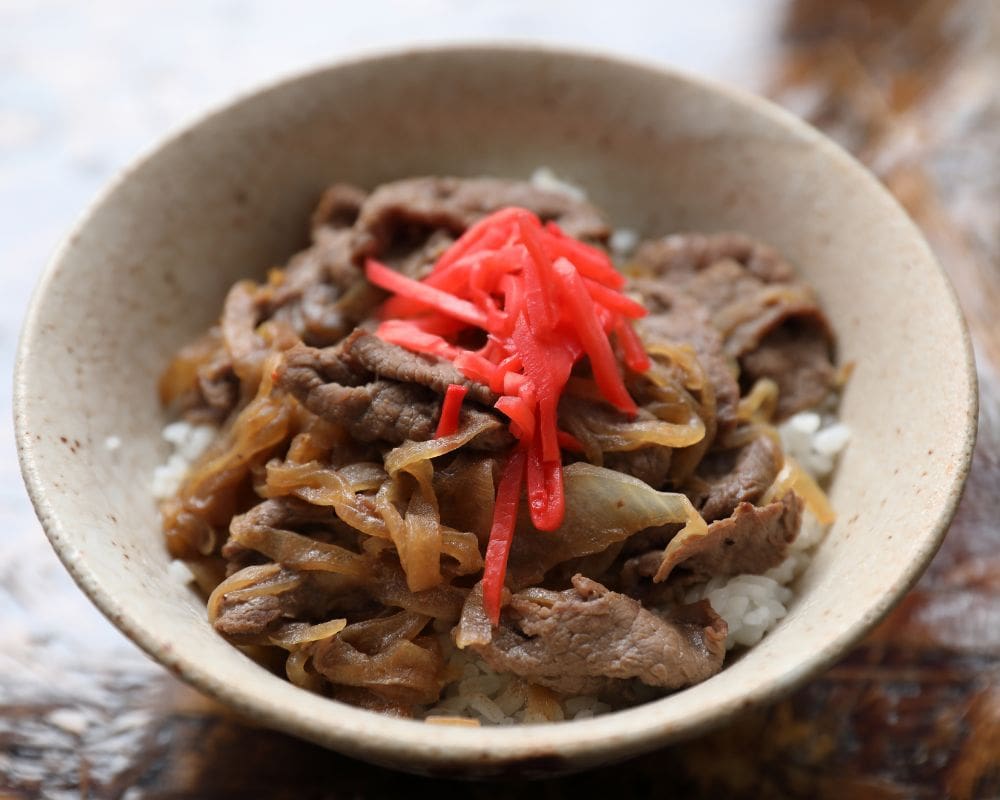
Gyudon, meaning “beef bowl,” is a famous food in Japan, consisting of thinly sliced beef and onions simmered in a mildly sweet sauce made from soy sauce, mirin, and sake, served over a bowl of steamed rice.
Originating in the late 19th century, gyudon became popular as a quick, affordable, and filling meal for busy workers and students. It’s now a staple dish in Japanese fast food, served in specialty restaurants nationwide.
Gyudon is an accessible and comforting introduction to Japanese flavors, combining the savory depth of the beef with the simplicity of white rice.
Fun Fact: Gyudon sparked a fast-food revolution in Japan, with major chains competing to offer the most delicious and affordable version of this beloved dish.
14. Kare Raisu (Japanese-style curry with rice)
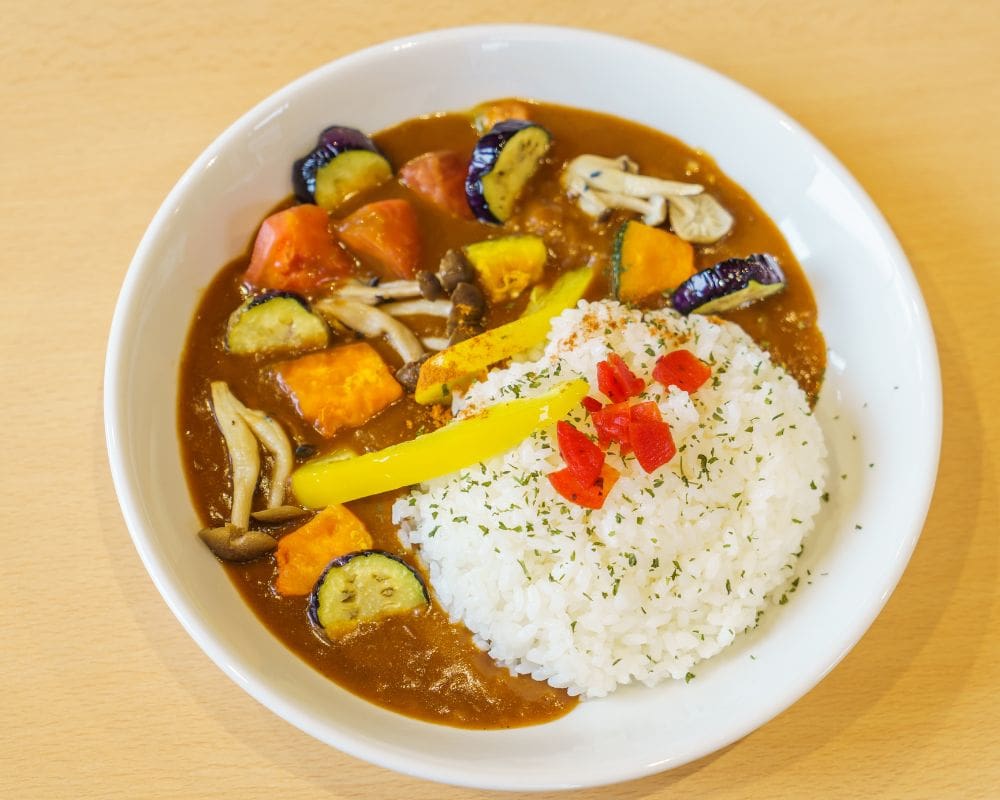
Curry Rice, or “kare raisu,” is a famous food in Japan, a beloved dish that reflects the adaptation of Indian curry to fit the Japanese palate.
Introduced to Japan by the British during the Meiji era (1868-1912), Japanese curry has evolved into a thicker, sweeter, and less spicy version than its South Asian counterpart.
It’s typically made with meat (usually beef, chicken, or pork), potatoes, carrots, and onions, and served over steamed rice. Curry rice is a staple in Japanese homes and curry restaurants, beloved for its comforting warmth and rich flavors.
Japanese curry offers a unique culinary experience, showcasing Japan’s ability to assimilate foreign dishes and make them distinctly their own.
Fun Fact: Curry rice is so popular in Japan that it’s considered a national dish, with curry roux blocks sold in supermarkets for easy home cooking.
15. Miso Soup (soybean paste soup with various ingredients)
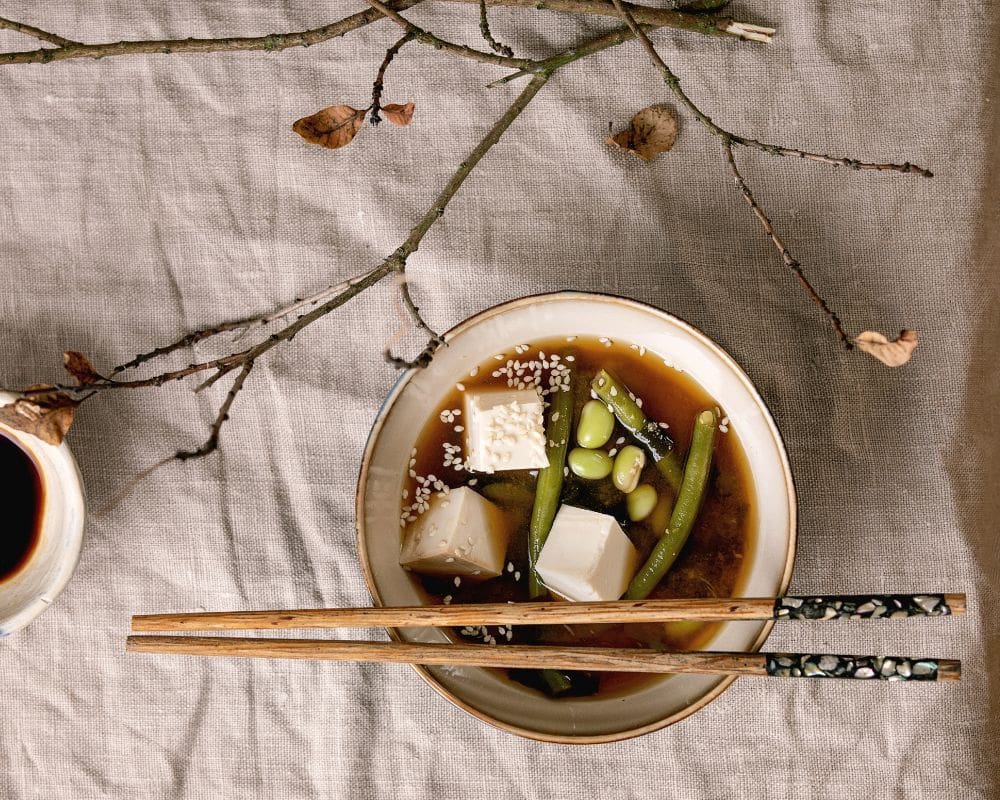
Miso soup is a staple of Japanese cuisine, served with nearly every meal. This famous food in Japan is made from a simple base of dashi (Japanese stock) and miso paste, a fermented soybean paste that is a fundamental ingredient in Japanese cooking.
The soup often contains various ingredients such as tofu, seaweed, and green onions, and can include seasonal vegetables or seafood, depending on the region or family recipe.
Miso soup has a rich history in Japan, dating back to the 8th century, and is revered for its health benefits, including aiding digestion and boosting the immune system.
The type and flavor of miso paste used can vary greatly by region, from the light and sweet white miso to the dark and robust red miso, each adding a unique depth and character to the soup.
If it’s your first time in Japan, miso soup is a comforting and flavorful introduction to the umami-rich world of Japanese cuisine.
16. Onigiri (rice balls with various fillings)

Onigiri, a quintessential Japanese snack, is a famous food in Japan that consists of hand-formed balls of rice filled with savory ingredients and often wrapped in nori (seaweed).
The history of onigiri dates back over a thousand years, serving as a portable and convenient meal for travelers and warriors.
These rice balls can be filled with a variety of ingredients, such as salted salmon, pickled plum (umeboshi), or tuna mayonnaise, offering a simple yet satisfying taste.
Onigiri provides a delightful insight into Japanese food culture, embodying the importance of rice in the Japanese diet.
Fun Fact: Onigiri has been a staple of Japanese picnics and school lunches for centuries, symbolizing comfort food that connects generations of Japanese people.
17. Tofu Dishes (Agedashi Tofu and Hiya Yakko)

Tofu dishes are an integral part of Japanese cuisine, showcasing the versatility of tofu made from soybeans.
Agedashi Tofu is a popular dish featuring lightly battered and fried tofu cubes served in a dashi-based broth, garnished with grated daikon and green onions.
Hiya Yakko is a simpler, chilled tofu dish topped with soy sauce, ginger, and green onions. Both dishes highlight the subtle flavors and textures of tofu, a staple ingredient in Japan since the Nara period (710-794 AD).
These tofu dishes offer a glimpse into the vegetarian aspect of Japanese cuisine, emphasizing the balance and delicacy of flavors.
Tofu has been celebrated in Japan for its health benefits, including being a high source of protein, making tofu dishes a common part of the Japanese diet.
18. Katsudon (breaded pork cutlet over rice)

Katsudon is a comforting and hearty dish, combining two favorites of Japanese cuisine: tonkatsu (breaded and fried pork cutlet) and donburi (rice bowl dish).
It involves a tonkatsu cutlet simmered with egg, onions, and a savory-sweet sauce, then served over a bowl of steamed rice. This dish is a famous food in Japan, often eaten before important events for good luck, as “katsu” is a homophone for “win” in Japanese.
Katsudon offers a satisfying meal that exemplifies the Japanese knack for layering flavors and textures.
Fun Fact: Katsudon is a popular choice among students before exams, hoping the dish will help them “win” or succeed.
19. Yakiniku (Japanese BBQ)

Yakiniku, meaning “grilled meat,” is a famous food in Japan, referring to a style of cooking similar to BBQ, where diners grill bite-sized pieces of meat and vegetables at their table.
This culinary practice became popular in Japan after World War II, influenced by Korean cuisine, and has evolved into a beloved dining experience. Yakiniku restaurants often feature a variety of meats, including beef, pork, chicken, and offal, seasoned with salt or dipped in a savory sauce.
For foreigners, yakiniku is an enjoyable and interactive way to experience Japanese cuisine, emphasizing the social aspect of dining. Yakiniku is not only about the food but also about the experience of cooking together, making it a favorite for gatherings and celebrations.
20. Unagi (grilled eel)
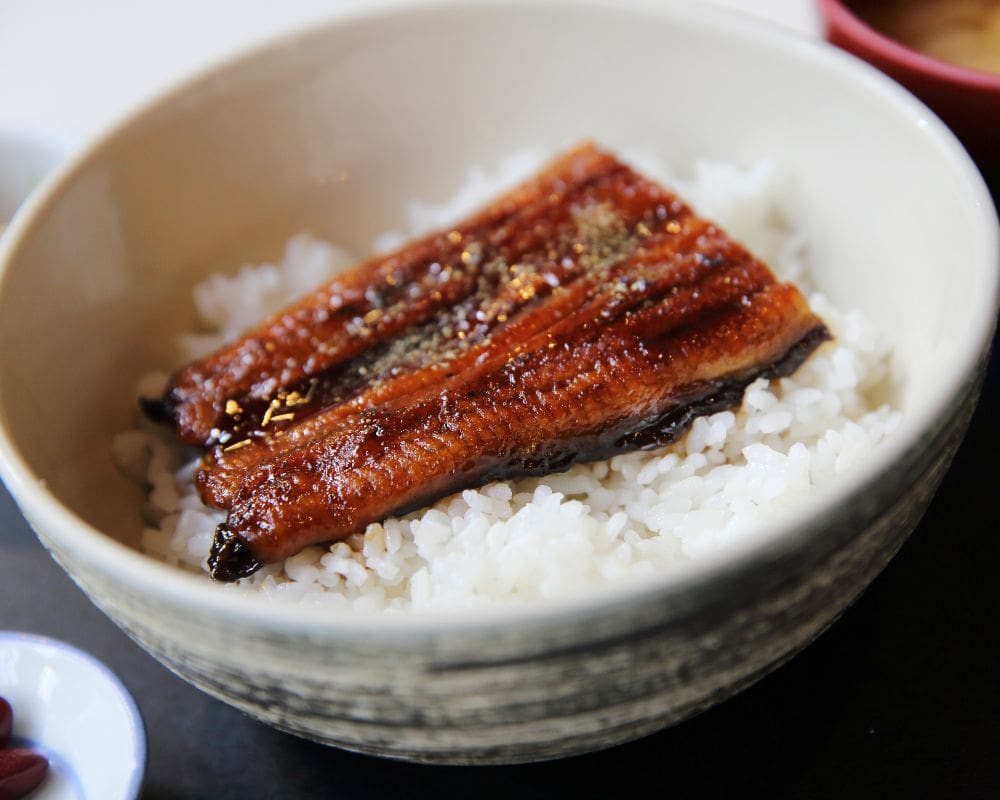
Unagi, or grilled eel, is a famous food in Japan, especially savored during the summer for its reputed stamina-boosting properties.
The eel is filleted, skewered, and grilled, typically glazed with a sweet soy-based sauce, resulting in a rich, tender, and flavorful dish.
Unagi has been part of Japanese cuisine for centuries, with the tradition of eating unagi on the midsummer day of the Ox (Doyo no Ushi no Hi) dating back to the Edo period.
It is an exquisite introduction to Japanese culinary traditions, offering a taste of Japan’s seasonal and celebratory eating habits.
Unagi is considered a delicacy and luxury food in Japan, with unagi restaurants dedicating themselves to perfecting the art of eel cooking, often passed down through generations.
21. Somen (thin wheat noodles, served cold)
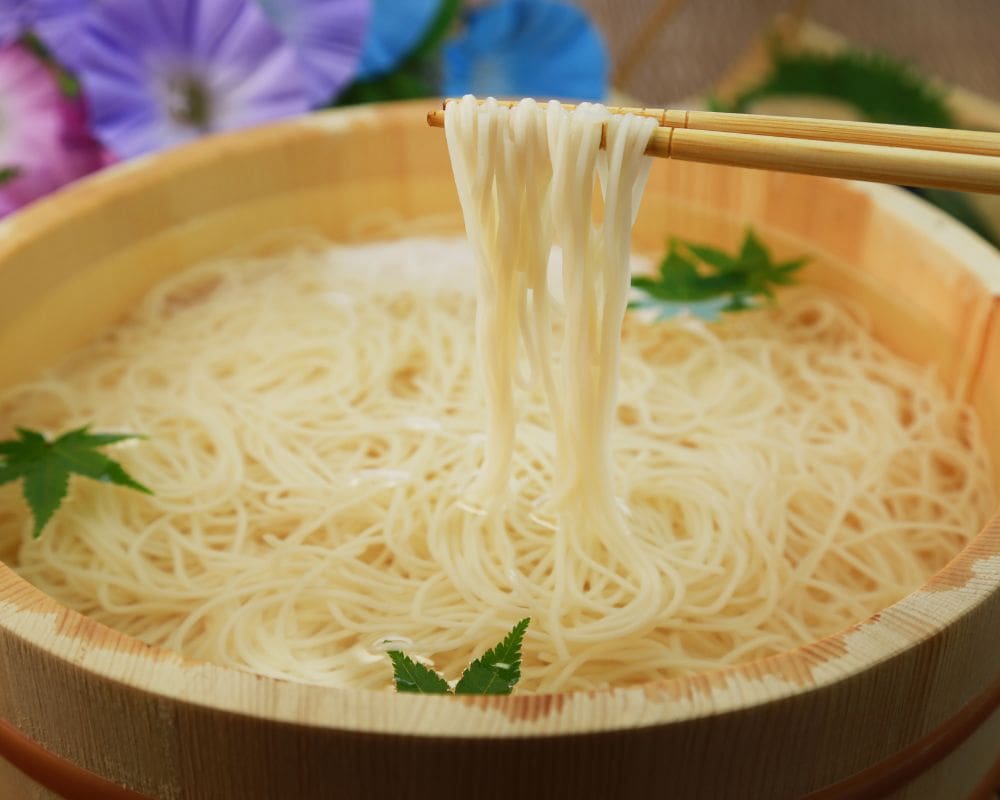
Somen is a traditional Japanese food that consists of thin wheat noodles served chilled, making it a popular dish during the hot summer months in Japan.
The history of somen dates back to the Nara period (710-794 AD), with evidence suggesting that it was originally consumed as a warm soup before evolving into the cold dish enjoyed today.
Somen noodles are known for their delicate texture and are typically served in a cold dashi-based broth with light seasonings such as soy sauce and mirin, accompanied by condiments like finely sliced green onions, ginger, and myoga (Japanese ginger).
Travelers might find somen a refreshing alternative to the more commonly known hot noodle dishes of Japan, offering a cool and light dining option.
Fun Fact: There is a unique way of eating somen called “nagashi somen,” where noodles are placed in a long bamboo flume with running water, and diners catch the noodles with their chopsticks as they flow by, adding a fun and interactive element to the meal.
22. Chawanmushi (savory egg custard)
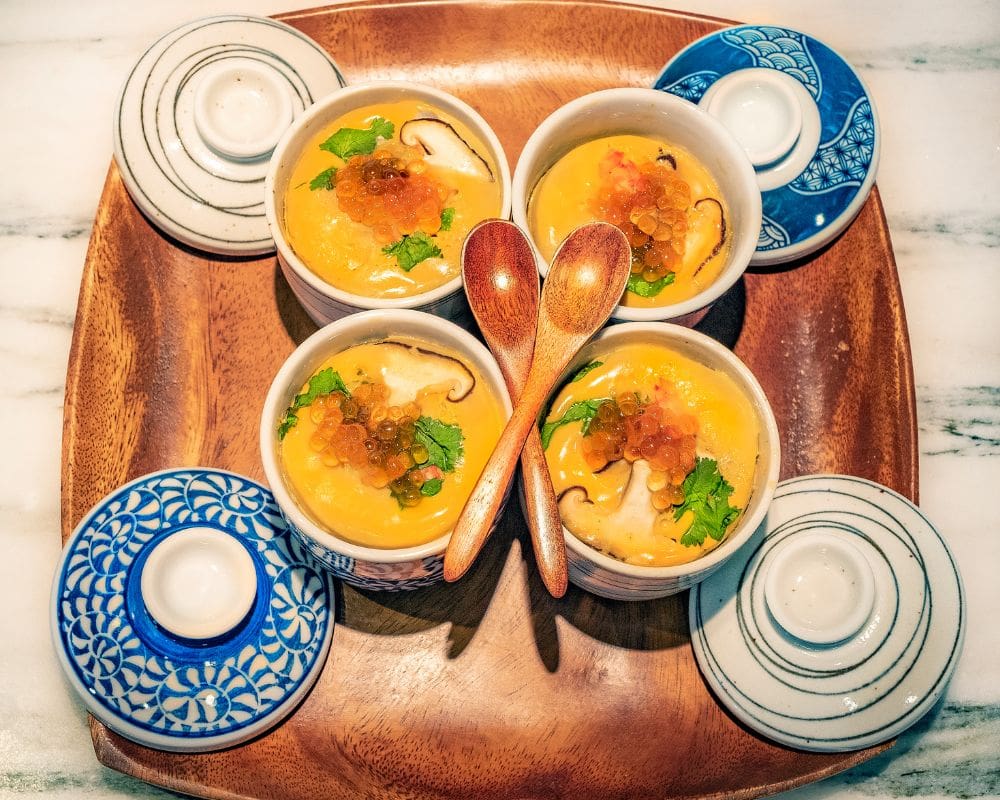
Chawanmushi is a traditional Japanese food that is a testament to the subtlety and elegance of Japanese cuisine.
This savory egg custard dish is steamed and usually served in a small cup or bowl (chawan). Its history can be traced back to the Edo period (1603-1868), where it was a luxury food item enjoyed by the upper classes.
Chawanmushi is made from a mixture of eggs and dashi (Japanese soup stock), flavored with soy sauce and mirin, and contains various ingredients such as shrimp, chicken, mushrooms, and ginkgo nuts.
Chawanmushi offers a unique culinary experience, combining the soft, silky texture of the custard with the umami-rich flavors of its assorted fillings.
Despite its delicate appearance, Chawanmushi is a protein-rich dish that showcases the Japanese skill in creating diverse flavors and textures from simple ingredients.
23. Nikujaga (meat and potato stew)
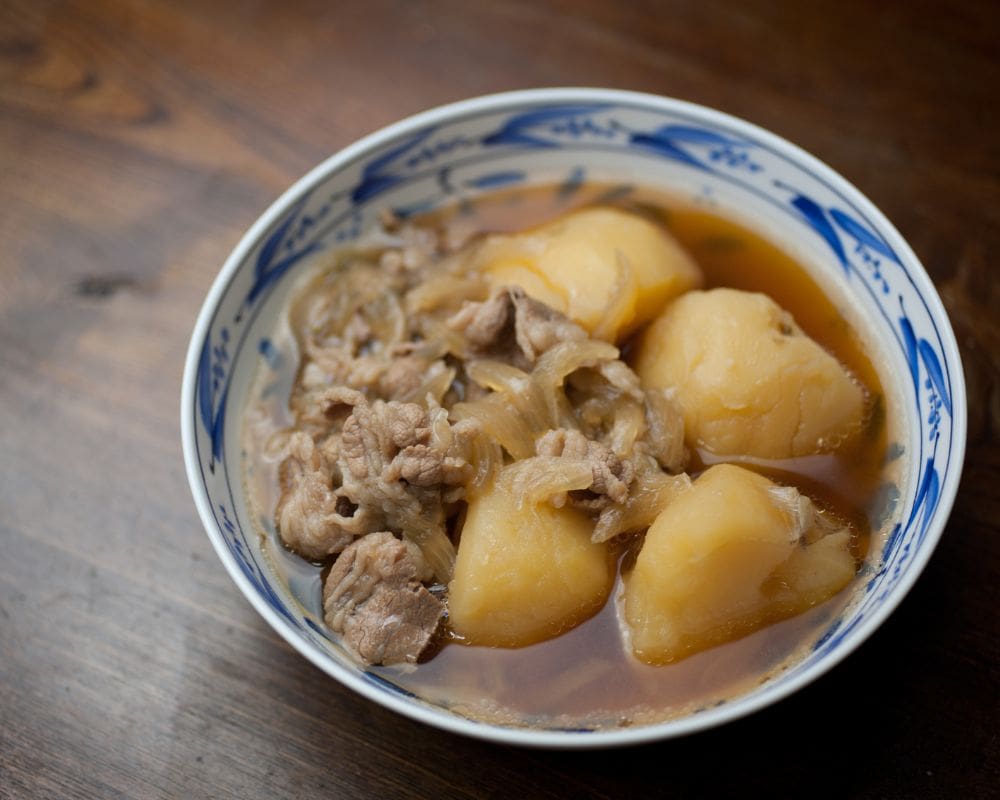
Nikujaga, directly translating to “meat and potatoes,” is a comforting and homey traditional Japanese food.
This dish was reportedly first created by chefs in the Imperial Japanese Navy in the late 19th century, inspired by the beef stews of the British Royal Navy, as an attempt to incorporate more meat into the Japanese diet.
Nikujaga consists of thinly sliced beef (or sometimes pork), potatoes, onions, and carrots, all simmered together in a sweet and savory sauce made from soy sauce, sake, and sugar.
It is a staple dish in Japanese households, representing the warmth and comfort of home cooking. Nikujaga serves as an accessible introduction to Japanese comfort food, reflecting the Western influence on Japanese cuisine.
Fun Fact: Nikujaga is often associated with motherly cooking in Japan, with many considering it a nostalgic dish that reminds them of home.
24. Oden (winter hot pot)

Oden is a traditional Japanese food that epitomizes the concept of winter comfort food in Japan.
This hot pot dish consists of a variety of ingredients such as boiled eggs, daikon radish, konnyaku (yam cake), and various processed fish cakes and balls, all simmered in a light, soy-flavored dashi broth.
The origins of oden can be traced back to the Muromachi period (1336-1573), evolving from a dish called “dengaku,” which referred to skewered tofu and konnyaku grilled and served with miso.
Over the centuries, oden has become a popular dish to enjoy during the colder months, often sold at convenience stores and specialty oden shops. Oden offers a glimpse into the Japanese appreciation for seasonal eating, with its warming qualities and communal style of dining.
Fun Fact: Oden is a common sight at Japanese convenience stores during winter, where it’s kept warm in large pots, allowing customers to select their preferred ingredients for a customized meal.
25. Gyoza (Japanese dumplings)
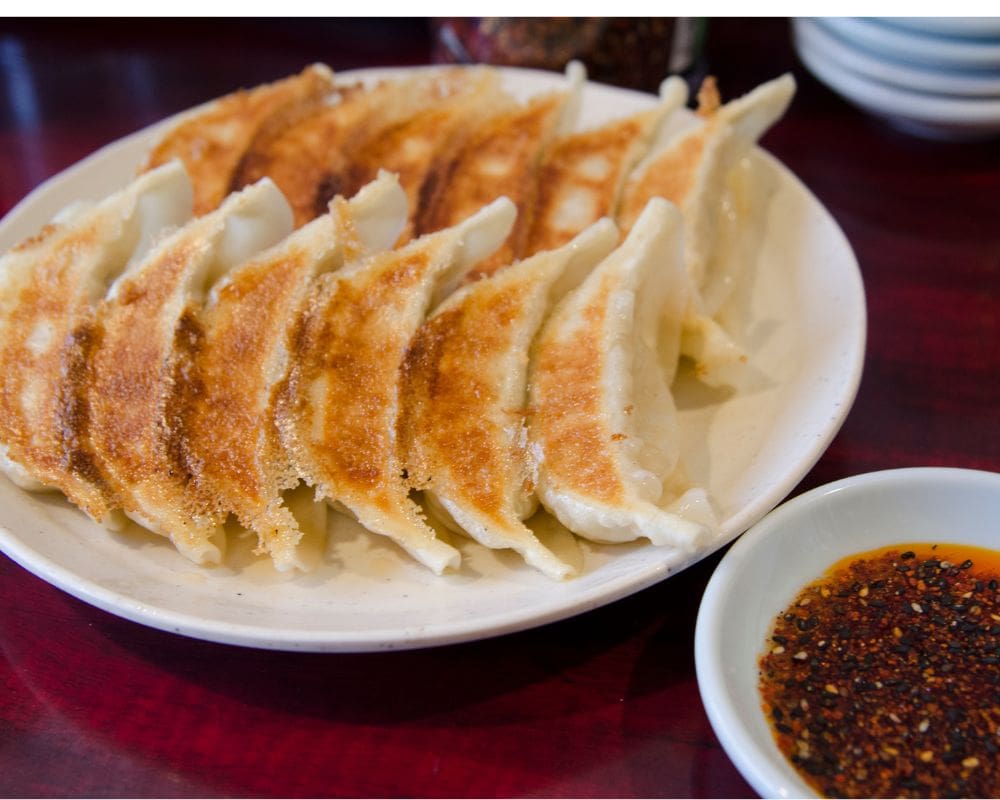
Gyoza, a traditional Japanese food, is Japan’s take on Chinese dumplings, introduced to Japan in the 20th century after World War II by Japanese soldiers returning from China.
These pan-fried dumplings consist of a thin wrapper filled with ground meat (usually pork) and vegetables (commonly cabbage, garlic, ginger, and green onion), crimped at the edges to seal.
Gyoza is typically pan-fried to create a crispy bottom, then steamed to ensure the filling is juicy and tender, and served with a dipping sauce made from soy sauce, vinegar, and chili oil.
Gyoza offers a delicious and accessible insight into the fusion aspect of Japanese cuisine, showcasing how foreign influences are integrated and adapted.
Fun Fact: While gyoza is enjoyed across Japan, the city of Utsunomiya is known as the gyoza capital of Japan, boasting a large number of gyoza restaurants and even a gyoza statue, highlighting the dish’s popularity and cultural significance.
26. Edamame (boiled soybeans)
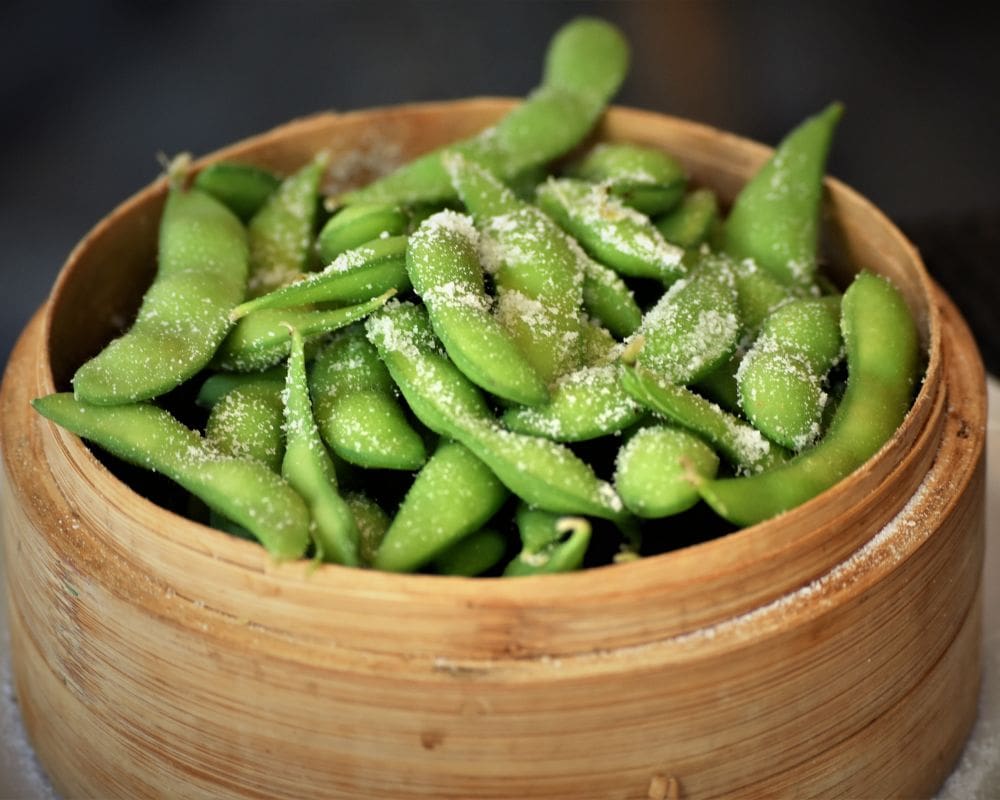
Edamame, boiled young soybeans still in their pods, is a traditional Japanese food often served as a snack or appetizer, especially alongside alcoholic beverages in izakayas (Japanese pubs).
The practice of eating edamame dates back to the 13th century, according to historical records, making it a longstanding staple of Japanese cuisine.
These soybeans are typically boiled in water with a pinch of salt, resulting in a simple yet utterly satisfying dish. Edamame offers a glimpse into the Japanese approach to food, where even the simplest ingredients are celebrated for their natural flavors.
Edamame is not only prized for its taste but also for its nutritional benefits, being high in protein, fiber, and vitamins, making it a popular health snack both within and outside Japan.
27. Tsukemono (pickled vegetables)
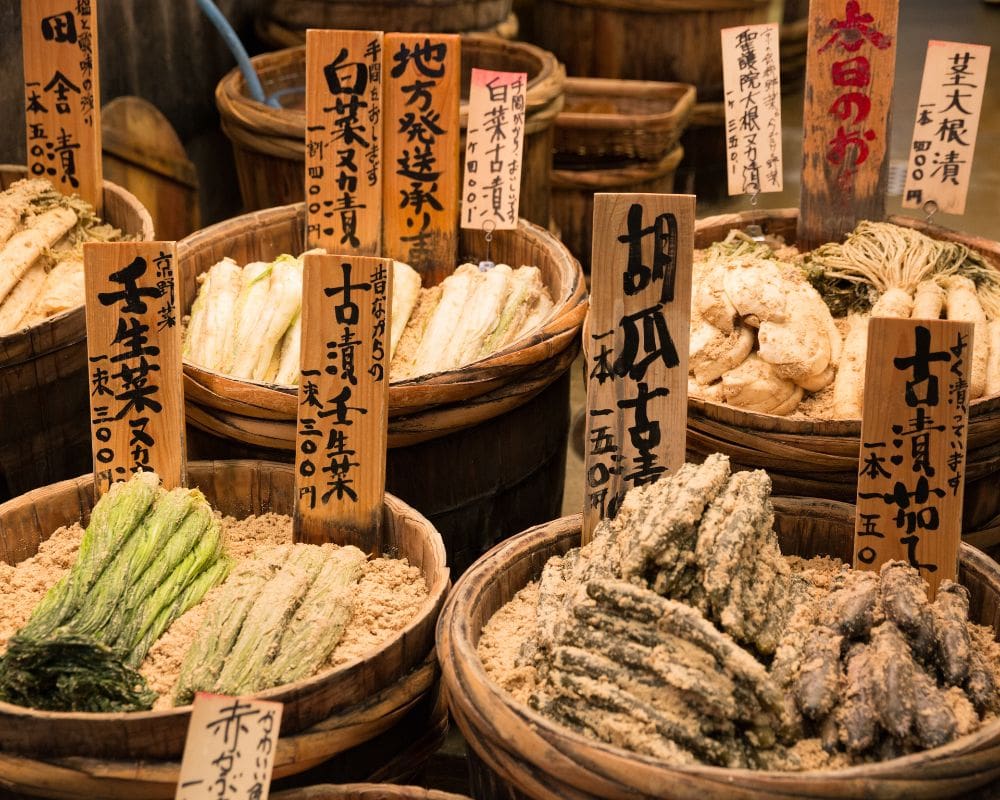
Tsukemono, or pickled vegetables, are an essential part of traditional Japanese food culture, serving as a staple side dish that complements main courses by adding crunch and refreshing acidity.
The practice of pickling vegetables in Japan can be traced back to the Heian period (794-1185), serving as a method for preserving food.
Various vegetables can be used, including radish (daikon), cucumber, and eggplant, pickled in several ways using salt, rice bran, vinegar, or miso.
Tsukemono showcases the Japanese penchant for balance in their meals, offering a palate-cleansing taste that contrasts well with richer flavors.
It’s not just a side dish; the process of making tsukemono, known as tsukemonoki, is considered an important culinary art in Japan, highlighting the culture’s deep respect for tradition and the seasons.
28. Nasu Dengaku (miso-glazed eggplant)

Nasu Dengaku, a traditional Japanese food, consists of eggplants sliced and broiled with a sweet and savory miso glaze.
This dish is a staple of Japanese cuisine, with its roots in the Muromachi period (1336-1573), reflecting the long history of miso’s use as a versatile seasoning in Japan.
The combination of the creamy texture of the eggplant with the rich umami flavor of the miso makes Nasu Dengaku a favorite among Japanese and foreigners alike. It exemplifies the Japanese culinary principle of highlighting the natural flavors of the ingredients.
Fun Fact: “Dengaku” refers to a style of grilling with miso, named after the skewered mochi dishes that were sold during the traditional Japanese Dengaku festivals, showcasing the cultural significance of food in Japanese festivities.
29. Karaage (Japanese fried chicken)
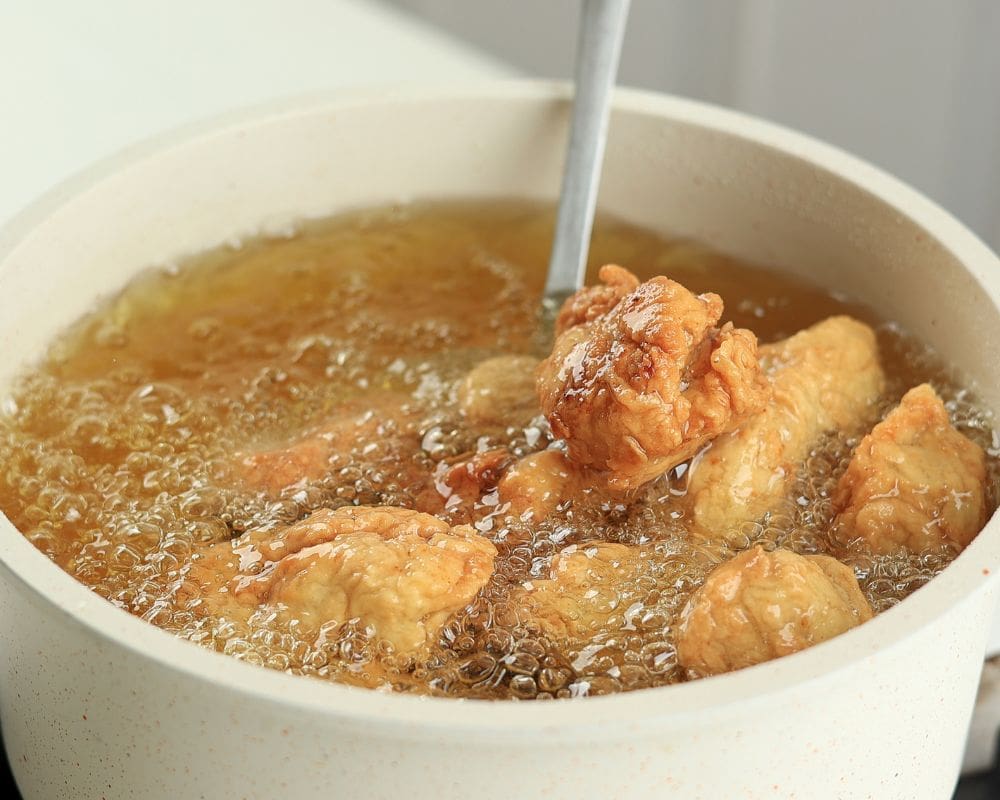
Karaage is a beloved traditional Japanese food known for its marinated chicken pieces that are lightly coated in flour or starch and deep-fried. This cooking technique was adapted from Chinese cuisine and has become a staple in Japanese bento boxes, izakayas, and at home.
What sets karaage apart is the marination process, typically involving soy sauce, ginger, and garlic, which infuses the chicken with a deep, savory flavor before frying. Karaage offers a delicious introduction to Japanese comfort food, showcasing the skill of Japanese cuisine in creating dishes that are both simple and deeply flavorful.
Fun Fact: Karaage is a popular choice at Japanese festivals and outdoor events, often enjoyed with a squeeze of lemon juice to enhance its flavor, highlighting its role as a versatile and universally loved dish.
30. Teppanyaki (cuisine cooked on an iron griddle)
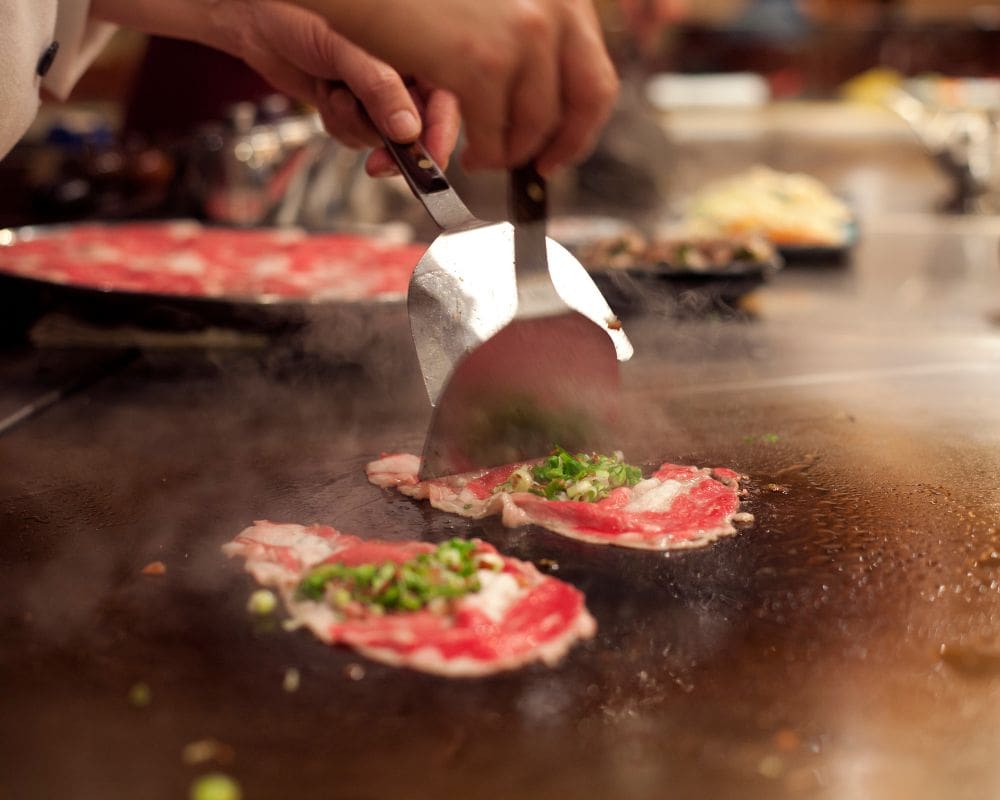
Teppanyaki, a style of Japanese cuisine that involves cooking food on a large iron griddle, is a traditional Japanese food that has gained international fame.
The word “teppanyaki” is derived from “teppan,” meaning iron plate, and “yaki,” meaning grilled, broiled, or pan-fried.
Introduced in the post-World War II era, this cooking method was initially used to prepare steaks for American and European guests in Japan, emphasizing entertainment and interactive cooking.
Ingredients typically include beef, chicken, seafood, and vegetables, all cooked together on the griddle and often served with rice and miso soup. Teppanyaki provides not just a meal but a culinary show, where chefs display their skills with flair and precision.
Fun Fact: Teppanyaki played a significant role in introducing Japanese cuisine to the world, with teppanyaki restaurants becoming popular globally for their combination of delicious food and engaging dining experience.
31. Fugu (pufferfish)
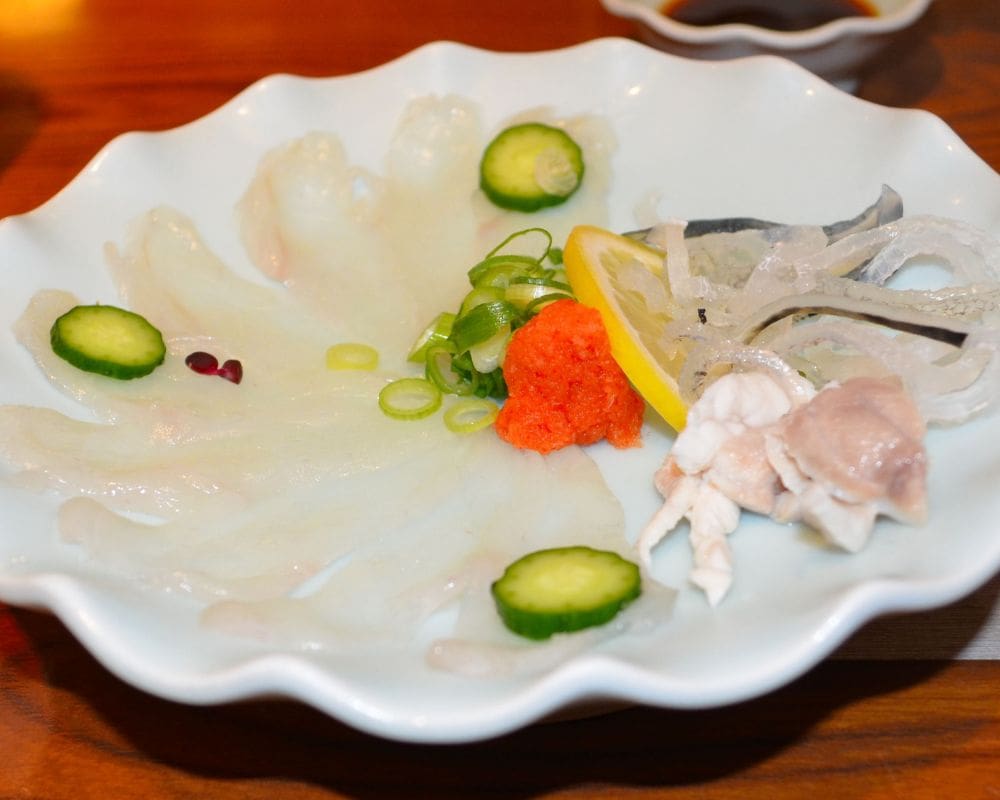
Fugu, or pufferfish, is a traditional Japanese food that is as notorious for its potential lethality as it is celebrated for its delicate flavor.
The history of fugu consumption in Japan is ancient, with evidence suggesting it was eaten as far back as the Jomon period (14,000–300 BCE).
Fugu contains lethal amounts of the poison tetrodotoxin, especially in its liver and ovaries, necessitating chefs to undergo years of rigorous training to obtain a license to prepare it safely.
Fugu offers an adventurous eating experience, underlined by the thrill of tasting something so exquisitely risky. This dish is typically served as sashimi (thinly sliced), but can also be prepared in a variety of ways, including in hot pots or deep-fried.
Fugu is not only a culinary delicacy but also a symbol of Japanese cultural identity and craftsmanship, reflecting the culture’s appreciation for both the beauty and danger inherent in nature.
32. Tamagoyaki (Japanese omelette)
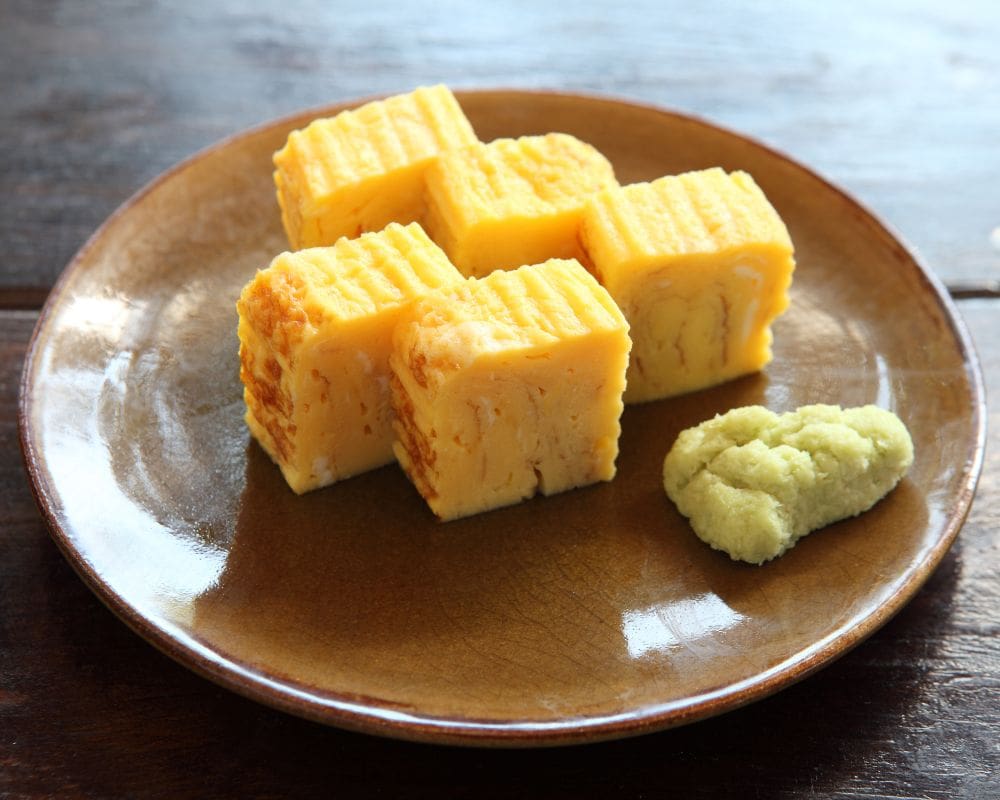
Tamagoyaki, a traditional Japanese food, is a sweet or savory omelette that is made by rolling together several layers of cooked egg.
These layers are often seasoned with sugar, soy sauce, and mirin, giving tamagoyaki a distinct flavor profile that is both rich and nuanced.
The dish has a storied history in Japanese cuisine, often served at sushi restaurants as a nigiri topping or included in bento boxes for a touch of homely comfort.
Tamagoyaki provides an insight into the Japanese approach to cooking, where attention to detail and technique can elevate even the simplest ingredients into an art form.
Tamagoyaki is commonly made using a rectangular pan, which helps achieve its characteristic shape, and watching a chef skillfully layer and roll the omelette is a mesmerizing experience, highlighting the precision and care that goes into Japanese cooking.
33. Matcha (green tea) desserts
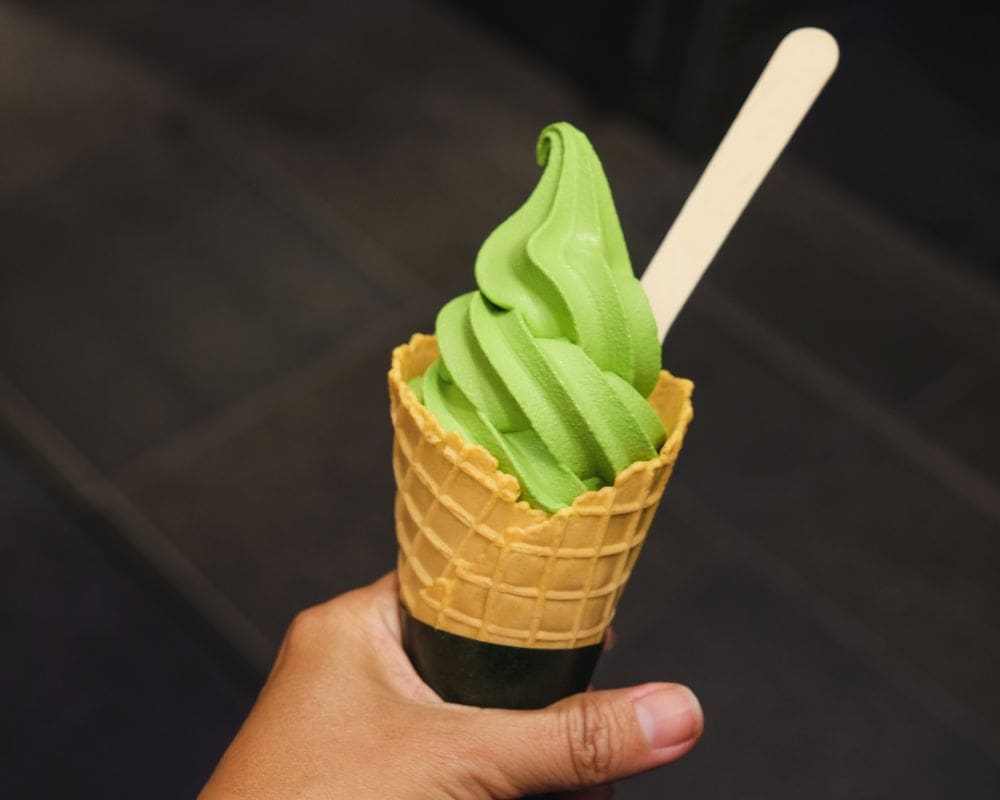
Matcha desserts, incorporating the finely ground powder of specially grown and processed green tea, have become an iconic representation of traditional Japanese food in the realm of sweets.
Matcha has been an integral part of Japanese culture since the 12th century, primarily associated with the Japanese tea ceremony, a symbol of hospitality and Zen philosophy.
In recent years, matcha has found its way into a variety of desserts, ranging from cakes and ice creams to traditional wagashi (Japanese sweets), offering a distinct, earthy flavor that balances the sweetness of the desserts.
Matcha desserts are an accessible and delightful way to experience the depth of Japanese culinary traditions, blending the ceremonial and the contemporary.
Matcha desserts not only appeal to the palate with their unique flavor but also offer health benefits due to the high antioxidant content of matcha.
34. Dorayaki (red bean pancake)

Dorayaki is a beloved traditional Japanese food, consisting of two small, fluffy, sweet pancakes sandwiched around a filling of sweet red bean paste. This dessert has roots in the Edo period but gained widespread popularity in the early 20th century.
Dorayaki is often associated with the fictional character Doraemon, where it is his favorite snack, which has contributed to its cultural significance and popularity among children and adults alike in Japan.
Dorayaki offers a taste of traditional Japanese sweets, showcasing the common use of azuki beans in Japanese confectionery.
Fun Fact: Dorayaki originally started as a single pancake with the bean paste spread over it, and the current form, resembling a sandwich, only became standard later on, illustrating how traditional dishes can evolve over time while remaining a cherished part of the cuisine.
35. Mochi (rice cake)
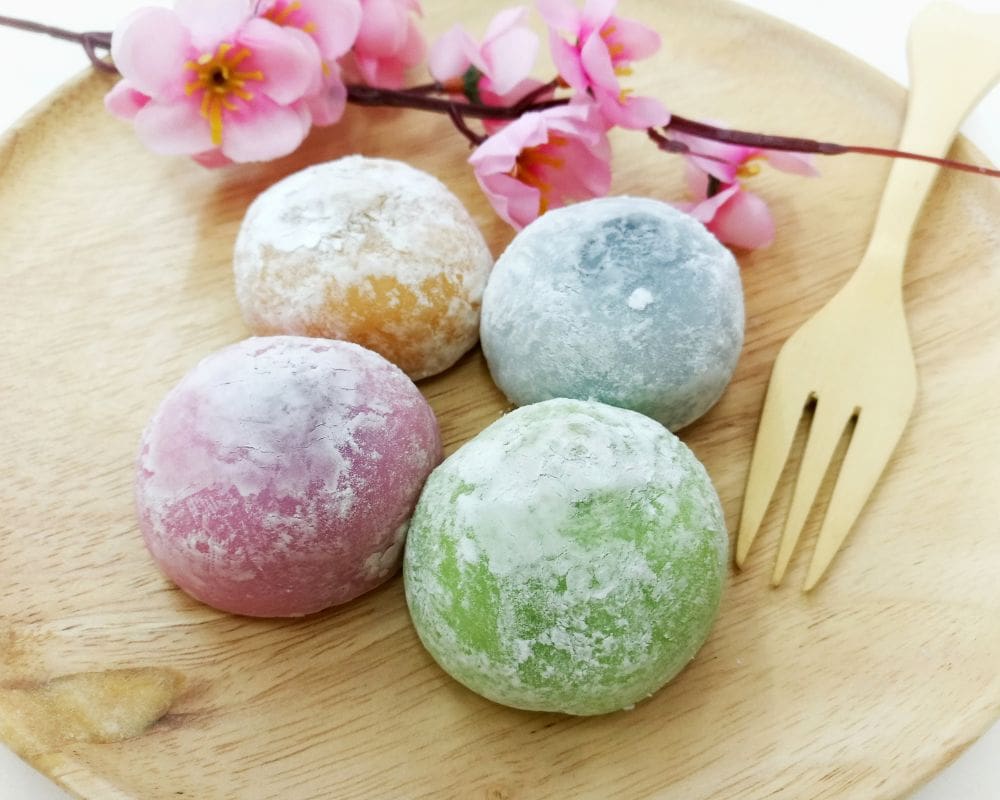
Mochi, a traditional Japanese food, is a sticky rice cake made from glutinous rice pounded into a paste and molded into shape.
This versatile dish has been enjoyed in Japan since the Heian period (794-1185) and is integral to various Japanese festivals and celebrations, including the New Year.
Mochi can be enjoyed in many forms, from sweet (filled with sweet red bean paste or covered in kinako soy flour) to savory (wrapped in seaweed or included in soups).
For first-timers in Japan, mochi is a fascinating introduction to the diverse textures of Japanese cuisine, offering a chewy, soft experience that is unlike most Western confections.
Fun Fact: Mochi is traditionally made in a ceremony called “mochitsuki,” where the rice is pounded with wooden mallets in a rhythmic manner, highlighting the communal aspect of Japanese food culture and the importance of tradition in the culinary arts.
36. Taiyaki (fish-shaped cake with filling)
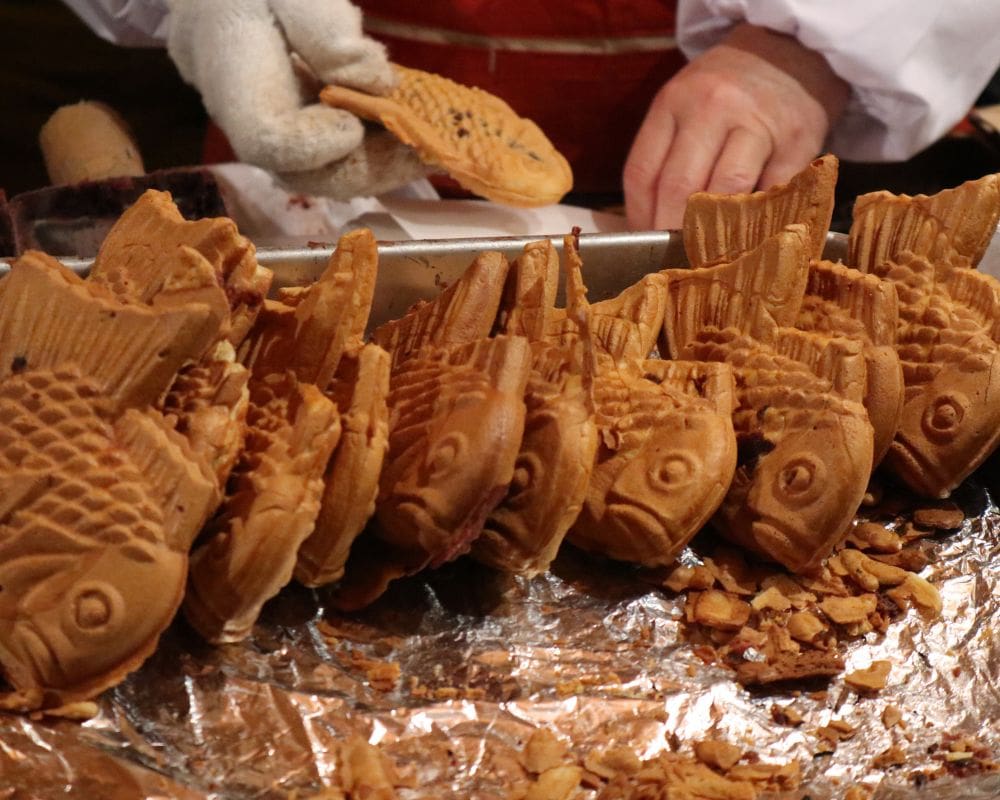
Taiyaki is a famous food in Japan, known for its distinctive fish shape and sweet filling, typically red bean paste made from sweetened azuki beans. However, modern variations include custard, chocolate, and sweet potato.
The origin of Taiyaki dates back to the Meiji era (late 19th to early 20th century), evolving from an earlier cake called ‘Imagawayaki’.
The fish shape is traditionally a sea bream, which in Japan is associated with good luck and auspiciousness, making Taiyaki not just a treat but a symbol of happiness and prosperity.
Fun Fact: Despite its fishy appearance, taiyaki has no fish—a playful twist that surprises many first-time tasters. This snack is particularly popular at festivals and street markets, where it’s cooked in specially molded pans to achieve its iconic shape.
37. Daifuku (mochi with sweet filling)

Daifuku, meaning “great luck,” is a famous food in Japan that consists of a soft and chewy mochi (glutinous rice cake) enveloping a sweet filling, most commonly anko (sweet red bean paste).
Its origins can be traced back to the late 18th century, evolving from a simpler form of mochi. Over time, daifuku has become a beloved treat, with variations including strawberry (ichigo daifuku) and ice cream filled mochi, reflecting both traditional and contemporary Japanese tastes.
Daifuku offers a unique texture and flavor experience, showcasing the versatility of mochi as a confectionery ingredient.
Fun Fact: Despite its sweet nature, Daifuku was originally considered a form of preserved food, illustrating how culinary practices can evolve significantly over time. Daifuku remains a popular gift and treat, especially during celebrations and seasonal events.
38. Kakigori (shaved ice dessert)

Kakigori is a famous food in Japan, especially during the hot summer months. This refreshing dessert consists of shaved ice, drizzled with flavored syrups, and often topped with condensed milk, fruit, or red bean paste.
The history of kakigori dates back to the Heian period (794-1185), where it was a luxury enjoyed by the aristocracy, as ice was a rare commodity. Today, it’s accessible to everyone, symbolizing the joy of summer in Japan.
Kakigori is a delightful way to experience a traditional Japanese summer treat, offering endless variations from classic to modern flavors.
Kakigori has inspired a range of similar desserts in other cultures, showcasing its widespread appeal. It’s not uncommon to find gourmet versions in cafes and speciality shops, elevating the simple shaved ice to an artisanal experience.
39. Anpan (sweet bread filled with red bean paste)
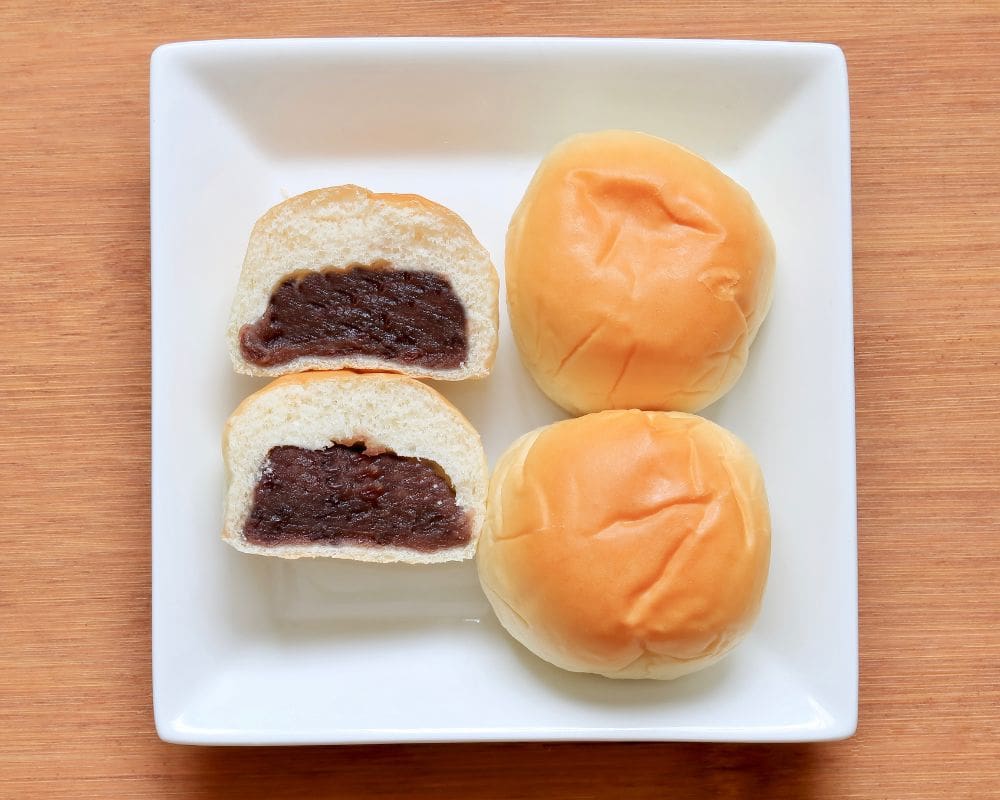
Anpan is a famous food in Japan that was first made in the late 19th century by a samurai turned baker, Yasubei Kimura.
It is a soft, sweet bread filled with anko (sweet red bean paste), marking a significant departure from traditional Japanese confections towards Western-style breads.
The creation of anpan coincided with the Meiji Restoration, a period of rapid Westernization and modernization in Japan, and it quickly became a favorite among Japanese people, including Emperor Meiji.
Anpan offers a taste of Japan’s fusion cuisine, blending the Western bread with the traditional Japanese sweet, anko.
Fun Fact: Anpan led to the popularity of other sweet breads in Japan, and it even has its own mascot, Anpanman, a superhero character in a children’s anime whose head is an anpan, symbolizing the dish’s cultural significance.
40. Sashimi (sliced raw fish or seafood)
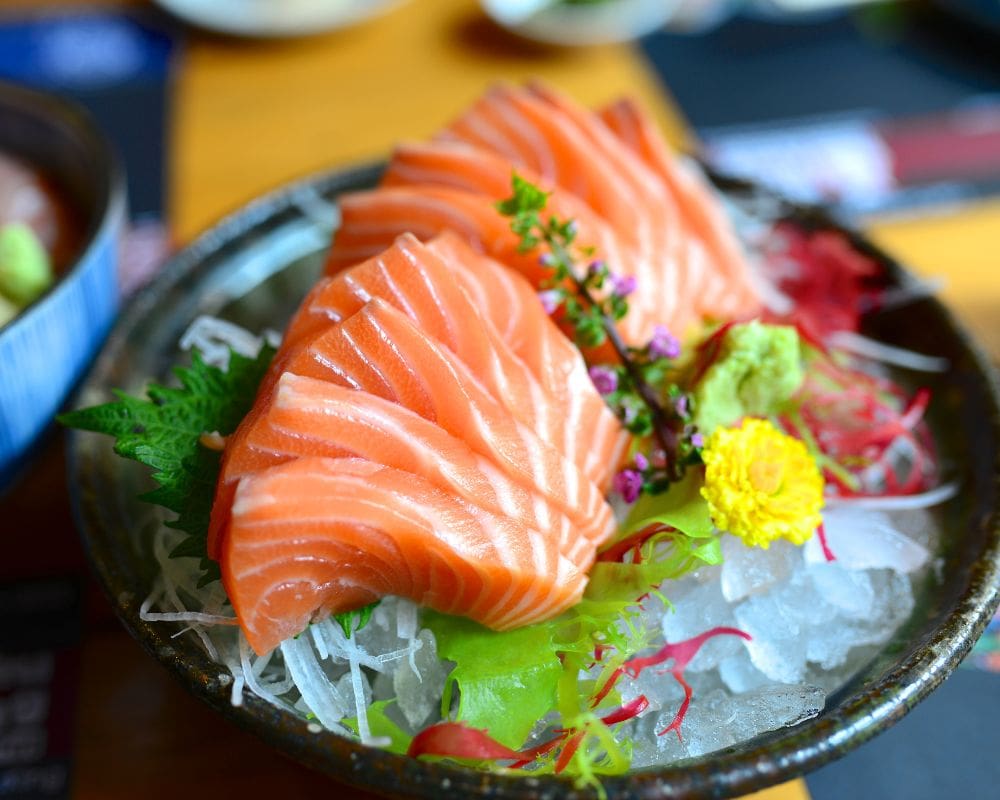
Sashimi, a famous food in Japan, consists of meticulously sliced raw fish or seafood, often served with soy sauce, wasabi, and pickled ginger. Unlike sushi, sashimi focuses solely on the flavor and texture of the fish, without rice.
The tradition of consuming raw fish in Japan dates back over a thousand years, with sashimi as it’s known today becoming popular during the Edo period (1603-1868).
Sashimi is celebrated for its simplicity and the skill required to prepare it, with each type of fish or seafood cut in a specific way to enhance its flavor and texture. Sashimi offers an exquisite culinary experience, highlighting the freshness and quality of Japanese seafood.
The arrangement and presentation on the plate are as important as the taste, with chefs often using natural elements like leaves and flowers to create a dish that is a feast for the eyes as well as the palate, embodying the Japanese aesthetic of seasonal beauty.
41. Bento (a single-portion take-out or home-packed meal)

Bento, a single-portion take-out or home-packed meal that is a famous food in Japan, has a rich history dating back to the Kamakura Period (1185–1333). These meals typically consist of rice, fish or meat, and pickled or cooked vegetables, neatly arranged in a box.
The concept of bento began as a simple way to feed people on the go, from travelers and warriors to workers and students. Over time, it has evolved into an art form, with elaborate arrangements designed to be both visually appealing and nutritionally balanced.
The bento box offers a compact yet diverse tasting experience, showcasing the Japanese knack for precision and aesthetics in cuisine.
“Kyaraben” (character bento), where the food is styled to look like people, animals, or characters from popular media, demonstrates the playful side of Japanese culinary culture and the deep care and thought that can go into meal preparation.
42. Zaru Soba (cold soba noodles with dipping sauce)
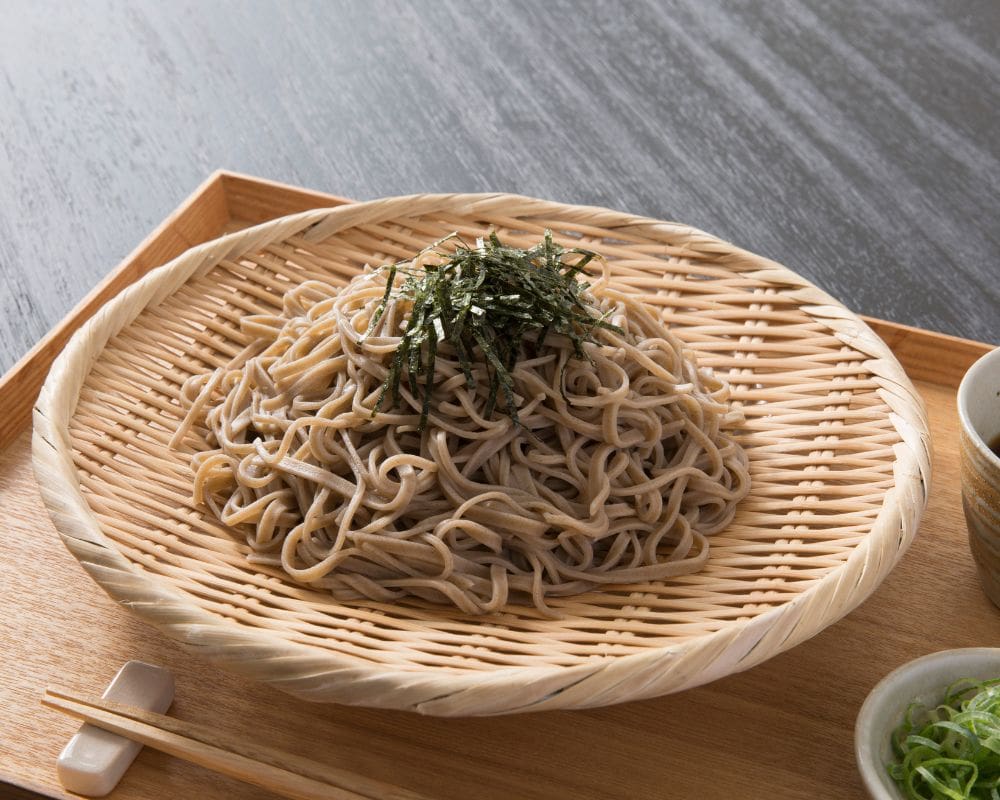
Zaru Soba, one of the famous foods in Japan, is a refreshing noodle dish served cold, perfect for hot summer days. The dish consists of buckwheat noodles that are boiled, then chilled in cold water and served on a bamboo mat (zaru) to drain.
Accompanied by a dipping sauce called tsuyu, made from a concentrated broth of dashi, soy sauce, and mirin, diners dip the noodles into the sauce before eating.
This dish traces back to the Edo Period (1603-1868), where it became popular for its simplicity and the cooling effect it had during Japan’s hot summers.
Zaru Soba is often garnished with nori (seaweed) and served with wasabi and finely chopped green onions, adding a variety of textures and flavors that complement the nutty taste of the soba noodles.
43. Hiyashi Chuka (cold ramen salad)

Hiyashi Chuka, literally meaning “chilled Chinese,” is a famous food in Japan that offers a cool respite during the sweltering summer months.
This dish consists of cold ramen noodles topped with an array of colorful ingredients such as sliced cucumber, tomato, ham, boiled egg, and sometimes chicken or shrimp, all drizzled with a tangy, often sesame-based, dressing.
Its origins can be traced back to Chinese-inspired dishes adapted by Japanese cuisine, becoming a staple summer food in Japan since the early 20th century.
Hiyashi Chuka provides a unique twist on the traditional hot ramen, showcasing the versatility of Japanese noodles. It is a seasonal dish, primarily available in restaurants during summer, highlighting Japan’s cultural emphasis on seasonal eating.
44. Kaki Fry (breaded and fried oysters)
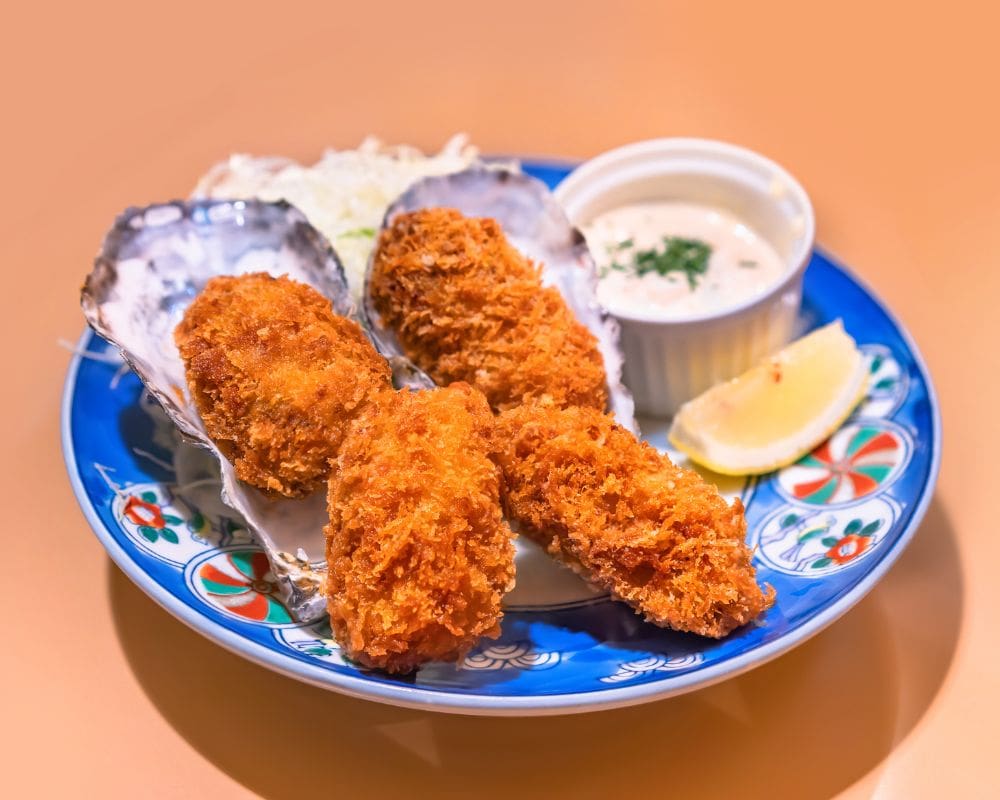
Kaki Fry, breaded and fried oysters, is a famous food in Japan, particularly beloved during the oyster season from October to March.
This dish features oysters coated in panko breadcrumbs and deep-fried until golden brown, served with a side of tartar sauce or a squeeze of lemon.
Kaki Fry originated from the Western-style of cooking, yoshoku, which was adopted into Japanese cuisine during the Meiji era (1868-1912) as Japan opened up to Western influences.
Kaki Fry exemplifies the Japanese talent for adopting and adapting foreign dishes in a way that complements their own culinary traditions, making them a beloved part of the national cuisine.
45. Tendon (tempura over rice)
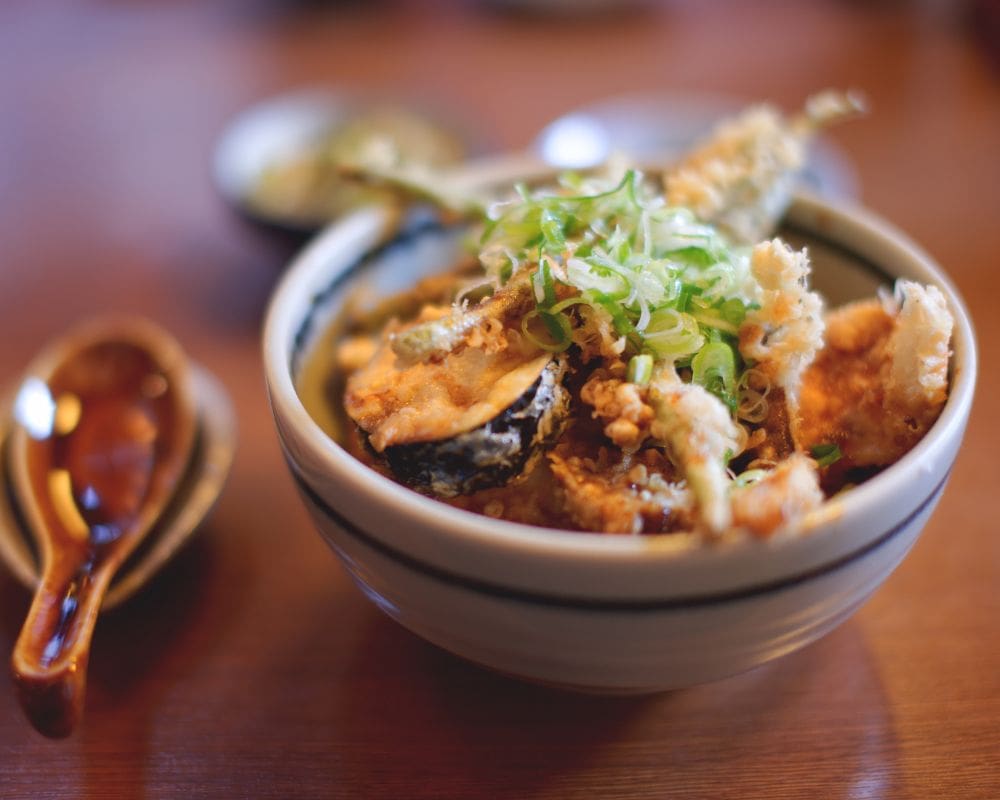
Tendon, short for “tempura donburi,” is a famous food in Japan that combines two beloved elements of Japanese cuisine: tempura and rice.
This dish consists of a bowl of steamed rice topped with an assortment of tempura, including shrimp, vegetables, and fish, all drizzled with a sweet and savory sauce made from dashi, soy sauce, and sugar.
The history of Tendon dates back to the Edo period (1603-1868) when tempura was commonly eaten by the working class. Tendon offers a hearty and satisfying meal, showcasing the crispy lightness of tempura against the soft, subtle flavor of Japanese rice.
Fun Fact: Tendon is considered a fast food in Japan, with many restaurants specializing in tempura and donburi offering this dish as a quick, delicious, and affordable meal option, reflecting the dynamic range of Japanese fast food beyond sushi and ramen.
46. Omurice (omelette over fried rice)

Omurice, a delightful fusion of Western and traditional Japanese dishes, is a popular comfort food in Japan.
This dish combines a chicken and ketchup-flavored fried rice (chikin raisu) with a thin, soft omelette wrapped around the rice, often drizzled with more ketchup or a demi-glace sauce on top.
The origins of omurice trace back to the early 20th century in Tokyo, symbolizing the beginning of Western influence on Japanese cuisine.
It is a testament to the adaptability and creativity of Japanese cooking, incorporating ingredients like ketchup, which were foreign at the time. Omurice provides a familiar yet distinctly Japanese taste experience, illustrating the blend of culinary cultures.
Fun Fact: Omurice is not only a beloved dish in homes and restaurants but also features prominently in Japanese pop culture, including manga and anime, signifying its integral role in modern Japanese culinary identity.
47. Natto (fermented soybeans)
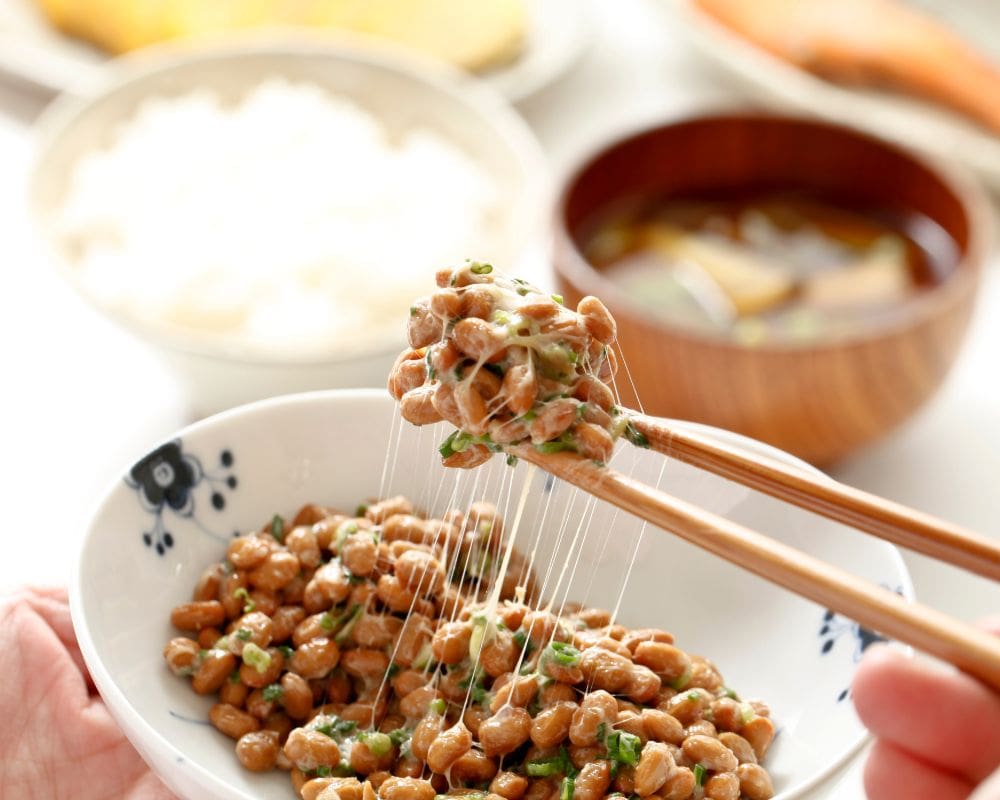
Natto, one of the most traditional Japanese dishes, is known for its strong smell, sticky texture, and numerous health benefits.
Made from soybeans fermented with Bacillus subtilis var. natto, this dish has been a staple in Japanese cuisine for over a thousand years, with its origins dating back to the Heian period (794-1185 AD).
Natto is often served over steamed rice and garnished with mustard, soy sauce, and sometimes chopped green onions. Despite its polarizing nature among foreigners due to its distinctive aroma and texture, natto is celebrated in Japan for its nutritional value, including being a rich source of protein, vitamins, and probiotics.
Natto is considered a superfood, credited with contributing to the longevity and health of the Japanese population, showcasing the deep connection between traditional Japanese dishes and wellness.
48. Yakisoba (fried buckwheat noodles)
Yakisoba, which literally means “fried buckwheat noodles,” is a misnomer since the dish is actually made from wheat flour noodles. It is one of the traditional Japanese dishes that perfectly encapsulates Japan’s street food culture.
Originating from the early 20th century, yakisoba is a quick and flavorful dish that includes noodles stir-fried with bite-sized pork, vegetables (typically cabbage, onions, and carrots), and flavored with a Worcestershire sauce-based seasoning.
Often garnished with mayonnaise, aonori (green seaweed powder), and pickled ginger, yakisoba is a staple at festivals and outdoor events. Yakisoba offers an accessible taste of Japanese cuisine’s savory side, characterized by its tangy and slightly sweet sauce.
Yakisoba is commonly prepared on teppan (iron griddles), which adds to the festive atmosphere of its preparation and consumption, making it a beloved and interactive culinary experience.
49. Japanese-style breakfast (includes grilled fish, miso soup, rice, and pickles)
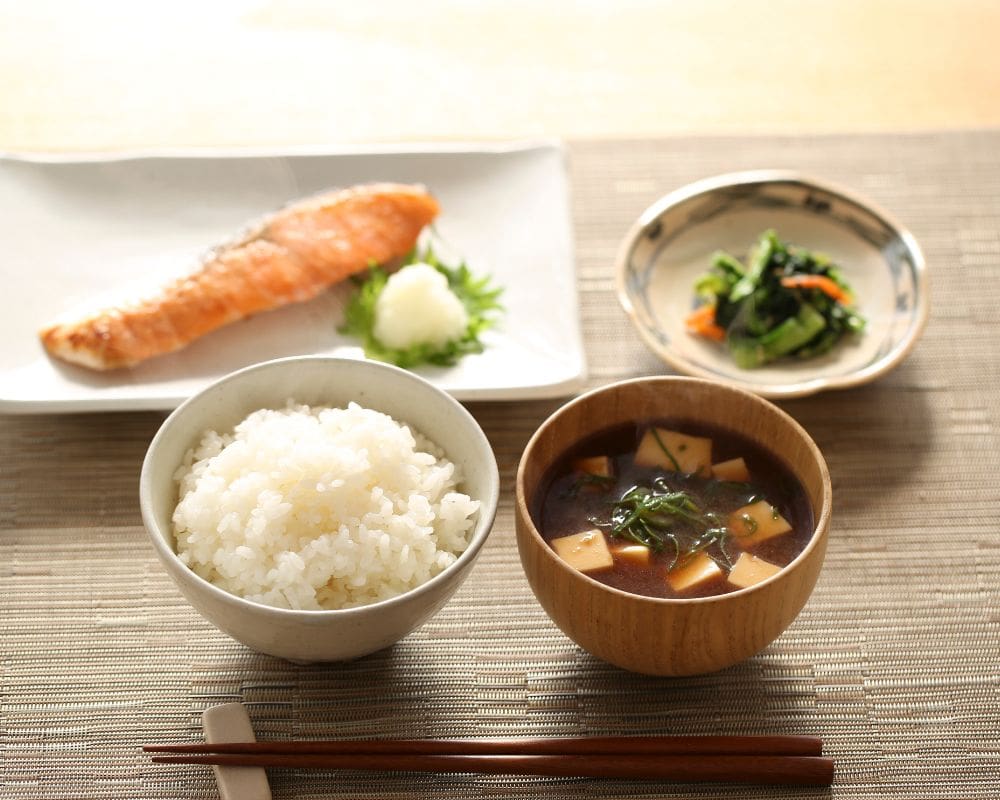
A Japanese-style breakfast is a traditional and balanced meal that showcases the diversity and nutritional philosophy of traditional Japanese dishes.
Typically, it includes grilled fish, miso soup, steamed rice, and pickles (tsukemono), offering a harmonious blend of flavors and textures.
This type of breakfast has its roots in Japan’s agricultural society, reflecting the importance of fish and rice in the Japanese diet. The inclusion of miso soup and pickles not only adds variety but also provides probiotics for digestive health.
A Japanese-style breakfast might seem elaborate compared to a Western breakfast, but it is an integral part of Japan’s culinary tradition, emphasizing the importance of starting the day with a nourishing and balanced meal.
Breakfast in Japan sets the standard for the Japanese concept of a meal, with one soup and three sides (ichiju sansai), symbolizing the meticulous care and thought put into Japanese food.
50. Wagashi (traditional Japanese sweets)

Wagashi are traditional Japanese sweets that are as much a feast for the eyes as they are for the palate.
Crafted from natural ingredients like azuki beans, rice flour, and agar-agar, wagashi come in an array of shapes, colors, and flavors, often inspired by the seasons and natural landscapes.
These confections have a deep history rooted in the tea ceremony culture of the Edo period (1603-1868), designed to complement the bitter taste of matcha (green tea). Wagashi offer a unique insight into Japanese aesthetics and the cultural reverence for nature and the changing seasons.
Many varieties carry poetic names and are shaped like flowers, leaves, or fruits, reflecting seasonal motifs and festivals. This artistry not only showcases the skill of the wagashi maker but also embodies the Japanese tradition of expressing respect and appreciation for nature’s transient beauty.


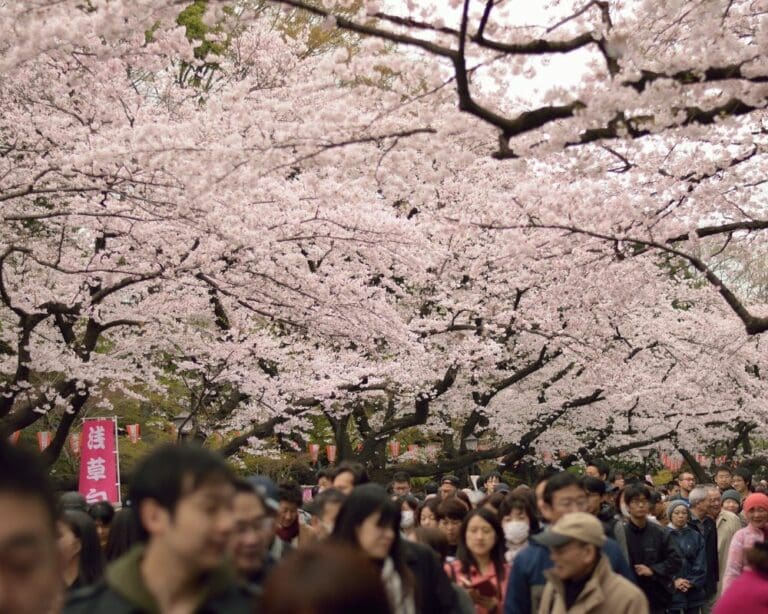
![The 8 Japan Regions, explained [with free map]](https://b3461660.smushcdn.com/3461660/wp-content/uploads/2024/02/Japan-Regions-Map-768x614.jpg?lossy=2&strip=1&webp=1)


